John Stoddart's personal reminiscences of train spotting days begins at Chester during the early Sixties and ends in Canada - a treat for curmudgeonly ex-spotters like me. His observations of a more innocent  age evoke fond memories of steam days long since forgotten...if you wish to discuss the contents of this page, John's email address is at the bottom of the page.
age evoke fond memories of steam days long since forgotten...if you wish to discuss the contents of this page, John's email address is at the bottom of the page.
Pre-train spotting railway memories are mostly of the branch line to Seacombe, across the Mersey from Liverpool and, with three platforms, as close as the Wirral Railway came to a major terminus. It was the starting point for day trips with mum to places like Caergwrle Castle, about twenty miles away. Fowler 2-6-2 tanks hauled trains of three or four non-corridor coaches, always filthy, always near empty. For young lads, the compartments of these old coaches, inaccessible between stations, were perfect mobile dens. Seats as thickly upholstered as a matron's bosom and luggage racks from which to launch ourselves onto them, raising clouds of sulphurous dust. Windows as opaque as a fish pond were raised and lowered by means of a leather strap like a barber's shop strop. The line closed in 1960 and became an approach to the new Mersey Tunnel.
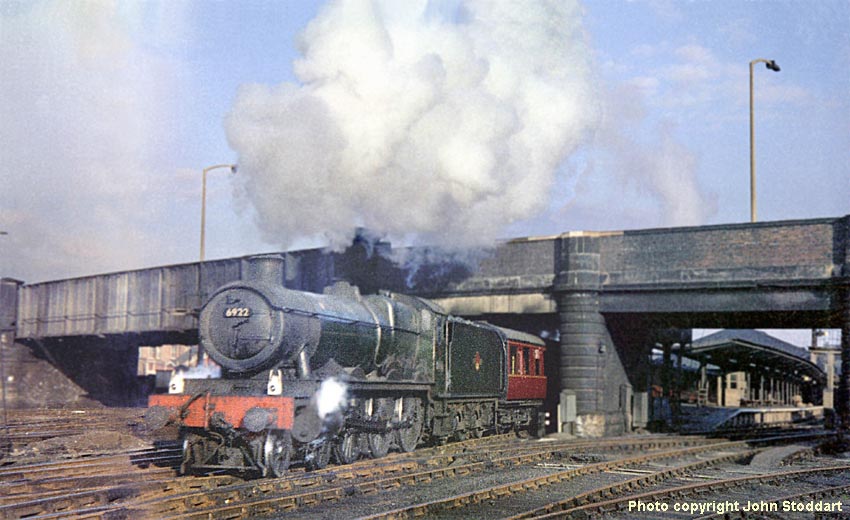
6922 Burton Hall pulls away from Chester General's Platform 2 with an evening train for Wolverhampton
Trainspotting started in the late 50s when my parents used to take us to the Robin Hood Holiday Camp in Prestatyn, a sort of poor man's Butlins if you can imagine such a thing. Chalets had been shoehorned, army camp style, onto a gravelly strip of land between the North Wales coast road and the main railway line where kids used to congregate to get away from their parents. We watched train after train carrying pasty-faced holidaymakers west and bringing their calamine-coloured, and smothered, counterparts back. Most of the engines were Stanier Black 5s, BR Standard 5s, or 'Crabs'. A very occasional 'namer' was celebrated with cartwheels by those kids who knew how to do them. One particular 'namer' inspired outrageous cartwheeling. Its number began with a 6 instead of 4 and it was called 'Harry Hinchcliffe', perhaps the name of some comedian doing a turn at a camp up the coast, I thought. When I googled him today I come up with a mythical tomb-robber, some link to bestiary and an accordion player. Seems like I wasn't far out.

(Above) 7922 Salford Hall bringing a rather short train past No 6 box into Chester. Behind the engine is the embankment into Northgate Station and, I believe, 6D shed. The building on the extreme left skyline with the imposing spire is that great seat of minimal learning, Victoria Road Primary School, underneath which all GWR and LMR trains bound for North Wales, passed.
Real trainspotting started when we moved to Chester in 1957, 200 yards from Chester General Station. From my bedroom window I looked over empty stock sidings at the western and northern approaches to the station as well as the line into Chester Northgate station on an embankment in the distance. Here was a train spotting cornucopia and no shortage of namers, thanks to the GWR. At school, I put my hand up for Inkwell Monitor after learning that inkwell duty coincided with the passage of the down Irish Mail through sandstone cuttings below the school. While two boys made up the days supply of ink and a third kept guard at the storeroom door, the fourth of the inkwell quartet hung onto life by a hair, extending far out of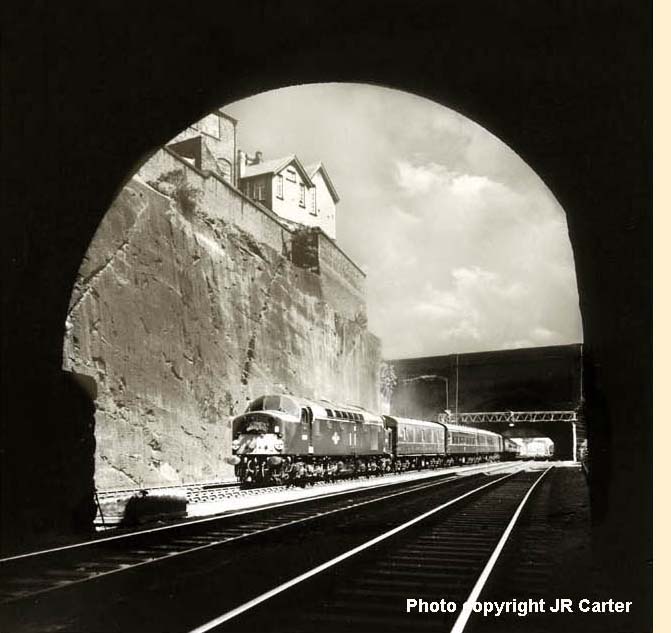 the window to catch the number on the engine passing two hundred feet below. At the first geyser of steam out of the tunnel mouth he yelled and we scrambled for our view of the cutting between his legs. That's how I first met 70045 "Lord Rowallan", a real name this time, not some music hall jester. Actually, as a sort of head scout it turns out, Rowallan was nothing more than a superannuated version of us inkwell monitors, but at least he had the sense to loan his name to an engine.
the window to catch the number on the engine passing two hundred feet below. At the first geyser of steam out of the tunnel mouth he yelled and we scrambled for our view of the cutting between his legs. That's how I first met 70045 "Lord Rowallan", a real name this time, not some music hall jester. Actually, as a sort of head scout it turns out, Rowallan was nothing more than a superannuated version of us inkwell monitors, but at least he had the sense to loan his name to an engine.
(Left-Below) Class 40 heading through the sandstone cuttings southwest of Chester General. It is about to pass under Victoria Road School where, in my imagination, latter-day inkwell monitors are doing some clandestine train spotting. Except that inkwells were long gone at the time of this picture, perhaps the school itself too. (Below) 46156 The South Wales Borderer leaving Platform 4 with a train for the North Wales Coast. As an Edge Hill engine in 1959 (although that does not look like an 8A shedplate in this picture) it was a common sight in Chester. The less couth of the train spotting fraternity would have called it a "stink". On the right were the GWR bays, 3, 2, and 1. Stanier Class 4 tank engines would hook onto the back of trains brought in by GWR engines, for the final leg to Birkenhead Woodside. Here, a jinty looks like it is taking stock out of one of the bays to the carriage sidings just off-picture right. The Jubilee class in the background right, is occupying the usual parking place for GWR engines waiting to back onto a train brought into the bays from Woodside. I lived two hundred yards away from the right hand edge of this photo.

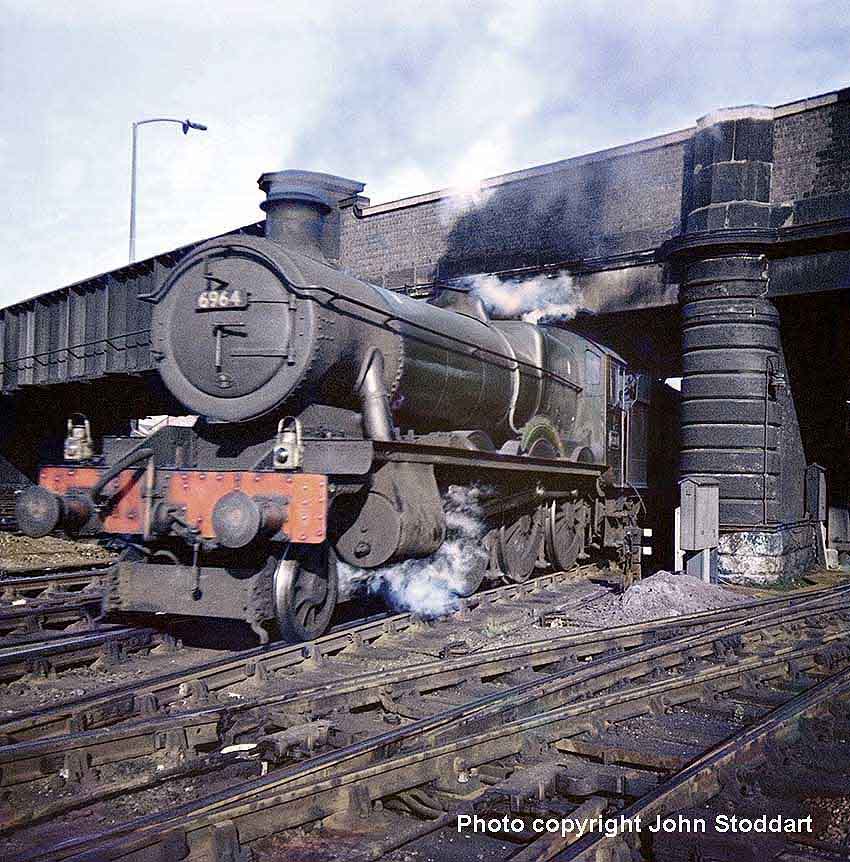
6964 Thornbridge Hall bursts from under Hoole Bridge with an afternoon Chester-Shrewsbury train.
So I started to haunt Chester General. Not the station itself, because platform tickets cost a penny and at various times station staff got on their high horses about spotters, persecuting them with a zeal that, at this distance in time, strikes me as worthy of psychiatric analysis. Most spotters congregated either side of Hoole Bridge at the west end of the station where you could see ninety percent of both LMR and GWR action. Ignorance is bliss and I found out, a few years later, that the odd train from Manchester or the other side of the Pennines would sneak into the bays on the east side. Late one summer Saturday afternoon I chanced on 46145 'Duke of Wellington's Regiment, West Riding' sitting in one of those bays at the head of a special from Leeds. A 55A engine, it gave me months of bragging rights over lads clumped at the opposite end of the station looking at 'Misterton Hall' for the umpteenth time.
At first I just marked down numbers and names in a ruled book but soon realized I'd better join Ian Allan's legions and, unable to afford the 'combine', forked out for his LMR and GWR subsets. It was the start of an outpouring of cash into railway books that, for me, still hasn't stopped.Chester was rich in variety of both Midland and Western loco power back then, as I came to understand, underlining numbers in almost every class over the summer months. Plenty of namers too, Halls, Granges, Counties, Castles, Manors from the Western Region, Scots, Pats, Jubs from the LMR, Brits from both sides of the family. I would have, should have, been a happy little lad. But my Ian Allan ABCs unlocked a nasty little secret. In the GWR section there were 30 engines with the names of English Kings that never showed up at Chester General. Likewise two classes from the LMR, 'Coronations' and 'Princesses'. What started as an "Oh, well," gradually became an obsession that took firm root when I found that some of Ian Allan's black and white photos disguised red engines. Red engines. Think of it. Offsetting all this dirty black, dirty green and paint that was totally unidentifiable, there were engines actually painted red. I saw pictures to prove it and the horrible truth dawned on me. I was trainspotting at a second class station. I was being excluded. Today, I could be described as having a syndrome, except they hadn't been invented yet.
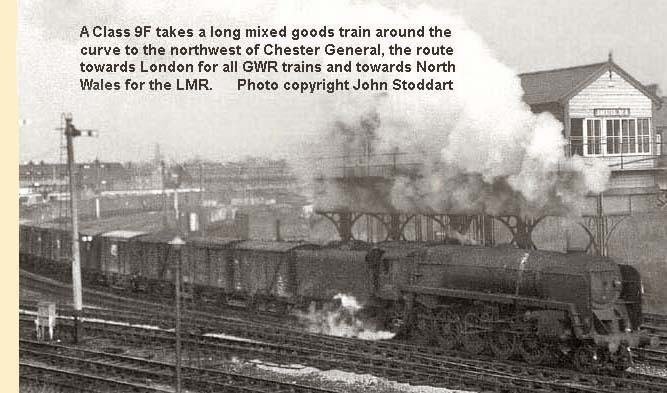 (Right) 9F takes a long mixed goods train around the curve to the northwest of Chester General, the route towards London for all GWR trains and towards North Wales for the LMR. I could see this curve from my bedroom window, sometimes just the tops of engines if sidings inside the curve were full. Many's the time I charged out of my house down to the station to identify an engine whose chimney I had just seen. I had a pair of plastic binoculars, but they gave roughly the same magnification as the naked eye with the addition of diffracted rainbows around the image.
(Right) 9F takes a long mixed goods train around the curve to the northwest of Chester General, the route towards London for all GWR trains and towards North Wales for the LMR. I could see this curve from my bedroom window, sometimes just the tops of engines if sidings inside the curve were full. Many's the time I charged out of my house down to the station to identify an engine whose chimney I had just seen. I had a pair of plastic binoculars, but they gave roughly the same magnification as the naked eye with the addition of diffracted rainbows around the image.
Apparently, loading gauge or permanent way restrictions kept Kings out of Chester, something to do with the Dee bridge having already fallen into the river once or Platform 3 having a funny curve on it. A friend and I took a train the short distance to Ruabon to meet an enthusiasts special there, rumoured to be King-hauled as far as that station. It showed up behind a Castle and was changed for something the conoscenti called a 'Dukedog', a quaint thing with outside frames looking like something over which O.S. Nock might get drooly, but doing nothing for me.
If, today, I cannot understand why I didn't travel the 20 miles to Crewe or perhaps double that to Shrewsbury where these forbidden delicacies were available en masse, all that means is I've forgotten how broke I was back then. Anyway, the problem was mostly solved a year or so later when I was grizzling to one of my classmates about Chester's shortcomings as a trainspotting venue and he twigged me to the fact that the 9.05 a.m. to Holyhead, originating in Crewe, had been showing up recently behind a 'Semi'. Although I refused to believe him I had to leave room for doubt. My spotting activities had ebbed over the winter and even at their peak hadn't encompassed 9 a.m. starts. Next Saturday I was down to the station like a jackrabbit, up to the head of platform 4 at one minute before nine where, already cocooned in a cloud of morning steam stood 46220 Coronation. The fact that it was green, not red, was immaterial. Nothing marred that first sighting of 46220 on a monochrome April morning. I had no camera with me, neither did I need one. The picture is etched on my brain.
(Below) Slumming it. 46256 Sir William A. Stanier, FRS, pulls
out of Chester for Crewe with a train of mixed empty stock.
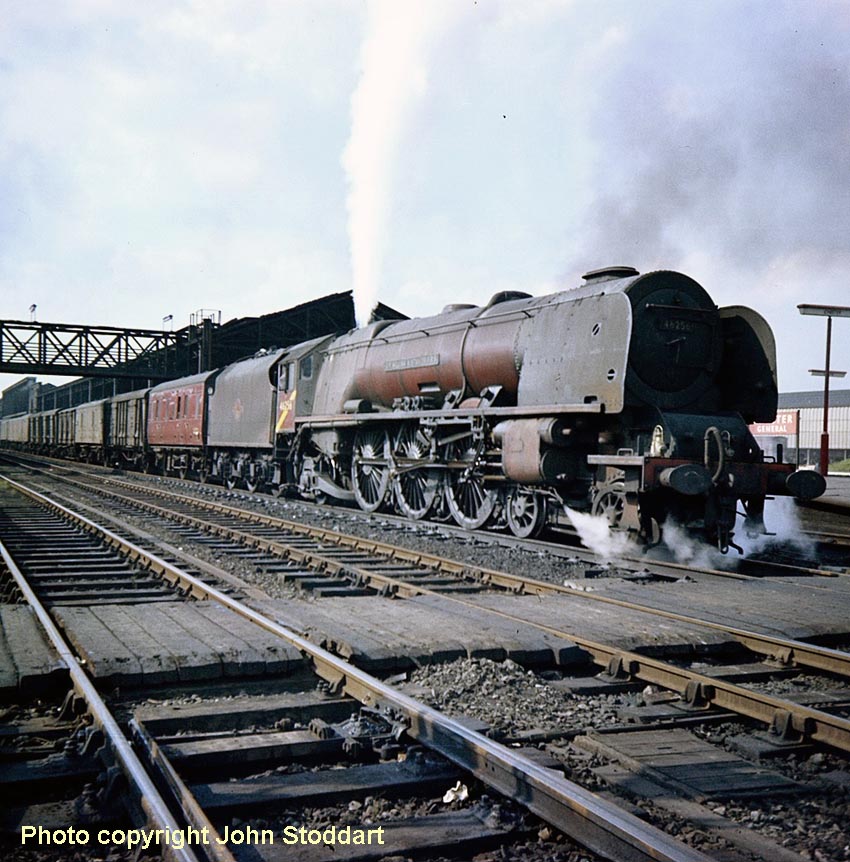
ENGINE SHEDS
When I first started trainspotting Chester had three sheds, 6A, 6E and 6D - the latter being a tiny thing serving Chester's second station, Northgate. 6E was the old GWR shed, right by the station, full of interesting things but very difficult to get into. Both of these sheds closed some time in the late 50s/early 60s. 6A was a way south east of the station between the Crewe and Manchester lines in the middle of a sort of wasteland. A ramshackle affair nondescript even by engine shed standards, it was approached by a dirt path that ran alongside the yard before circling round the back to the official entrance.
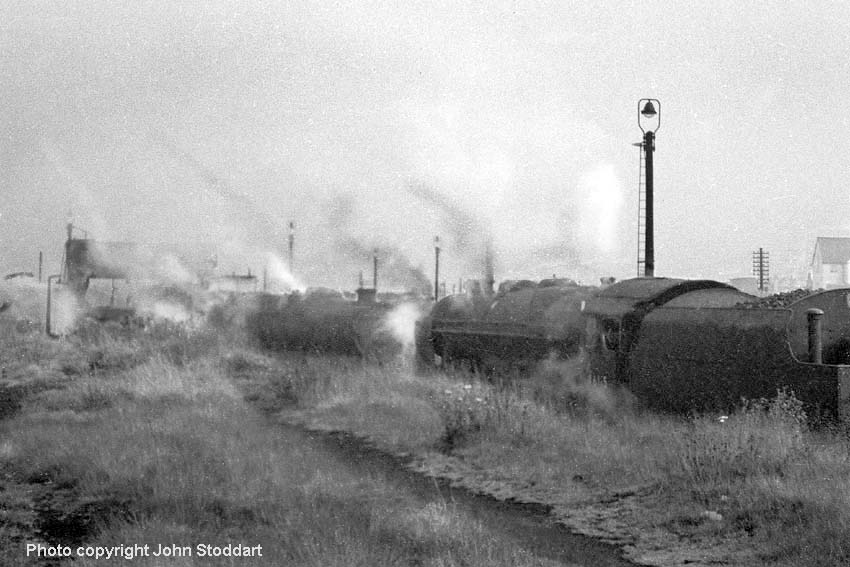
(Above-Below) From this picture I'd say it was a good thing the steam engine didn't make it into this century. New-agers allergic to perfume, pollen and life in general would have melted into the cinders, happening on this. Chester's 6A yard, side view, with a Scot and a couple of Black 5s. The Shropshire Union canal was just beyond the shed, and that house on the left housed a lock-keeper. (Below) The path to 6A shed. Most of what was worth seeing was usually out in the yard, often ex-works engines on a quick run-in from Crewe. Ex-works Semis looked odd in the middle of this lot, like go-go dancers in a theatre back alley.
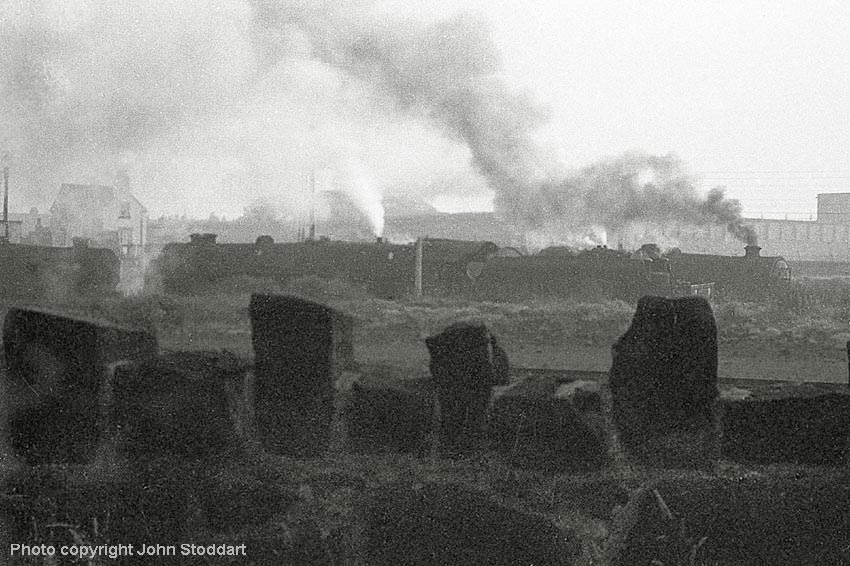

(Above-Below) The late Jim Carter's shot of 46248 City of Leeds on the Crewe line out of Chester. The train is about to pass 6A shed. You can just make out the path to the shed on the embankment, and the gentleman with the bike is probably heading out to work there. (Below) 6201 Princess Elizabeth coming into Chester from Crewe on an 'enthusiasts' special' in the summer of 1993. Believe it or not, behind the first coach is where I stood thirty years earlier to take the shed yard shot above. Chester 6A was just off to the right. It all looks very 'hygienic' now, I suppose, including 6201 which looks more like a Hamilton Ellis painting than a steam engine. But if I had a choice between returning to the '63 or the '93 scene and spending an afternoon there, it's '63 in a heartbeat.
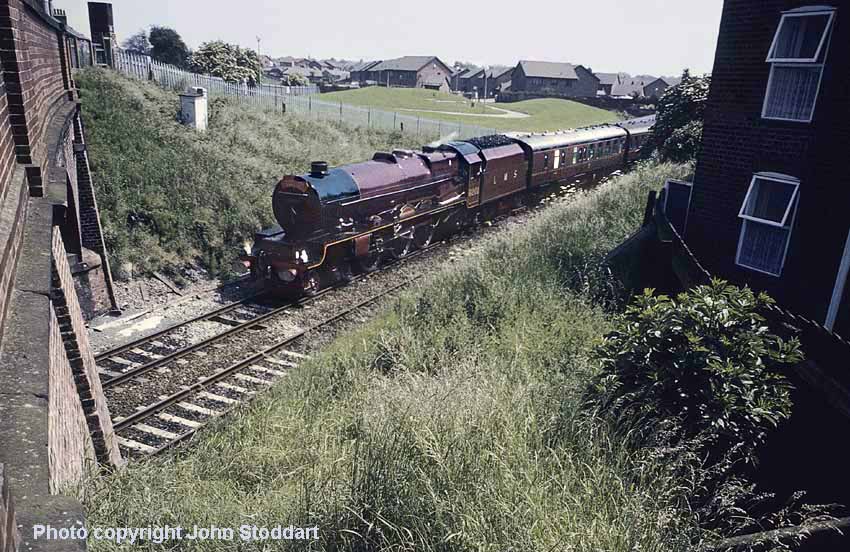

(Above) To bunk 6A, there was no need to consider the official entrance. You simply left the approach path at a point of your choice, walked across the yard, and you were in. To my knowledge there are no official rankings, but it had to be the easiest shed in Britain to bunk. Vaulting ash pits and skipping around moving locomotives at will, I cannot recall ever being asked what I was doing there. 70033, formerly Charles Dickens and a Manchester engine, replenishes at 6A's high-tech coal station.
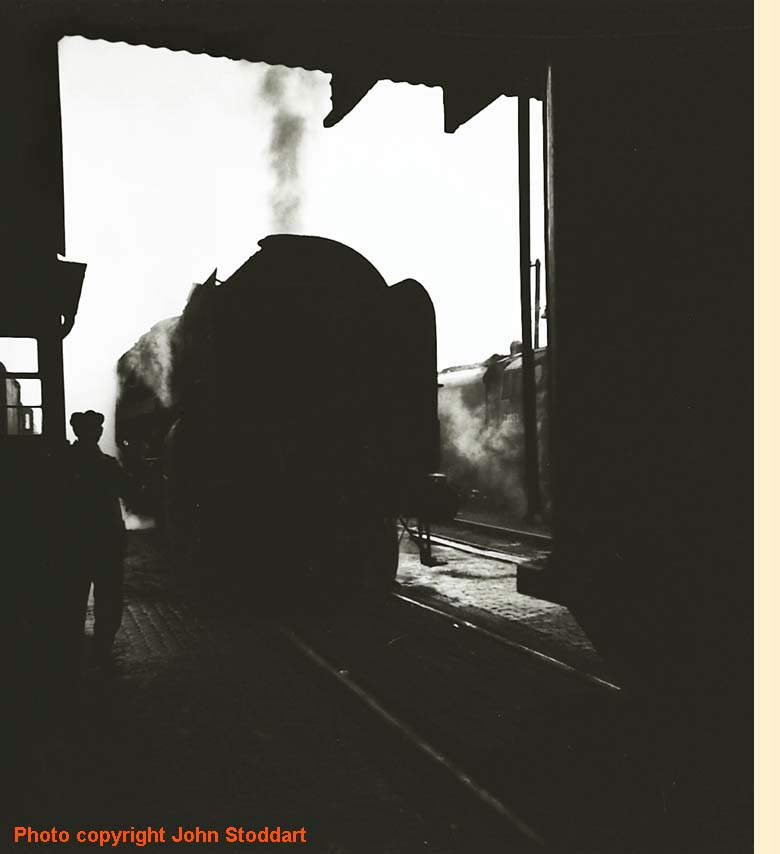 I loved shed-'bunking'. It often involved some climbing, a little hide-and-seek, brazenness, the thrill of the chase, all special things for boys who will be boys. The pleasure survived into teenage years. Shed reputations ranged widely. Crewe 5A varied according to the moon, more probably the mood of the foreman. But Crewe South, 5B, was always ridiculously easy. It involved a fair walk from the station but was worthwhile. Engines from everywhere collected there en route to and from Crewe Works. In Scotland, all sheds were easy to 'bunk'. They seemed to exist solely for the pleasure of spotters. At the other end of the scale 34A, Kings Cross, was reputed to be the toughest shed in Britain. There was story circulating that one gritty trainspotter had even donned a railwaymans' overalls to do 34A, and hadn't survived five minutes.
I loved shed-'bunking'. It often involved some climbing, a little hide-and-seek, brazenness, the thrill of the chase, all special things for boys who will be boys. The pleasure survived into teenage years. Shed reputations ranged widely. Crewe 5A varied according to the moon, more probably the mood of the foreman. But Crewe South, 5B, was always ridiculously easy. It involved a fair walk from the station but was worthwhile. Engines from everywhere collected there en route to and from Crewe Works. In Scotland, all sheds were easy to 'bunk'. They seemed to exist solely for the pleasure of spotters. At the other end of the scale 34A, Kings Cross, was reputed to be the toughest shed in Britain. There was story circulating that one gritty trainspotter had even donned a railwaymans' overalls to do 34A, and hadn't survived five minutes.
(Left) For me this picture, taken I believe at Polmadie, captures the essence of shed-bunking: the slickness of oil under foot, greasy rails, engines snoozing steam everywhere, latent power, always the chance that something will start moving, silhouetted figures that may or may not be hostile, the hot smells, the dripping of water.
BRITS
In the late 50s and early 60s a Chester trainspotter knew of two kinds of Brits: common as boredom, and as fabled as the phoenix. Into the first category fell ten Manchester-based engines like 70031 Byron and 70043 Lord Kitchener, and the five Holyhead locos that couldn't go anywhere without passing through our station, like 70045 Lord Rowallan and 70048, eventually given the honeyed title 'The Territorial Army 1908-1958'. All the rest were based down in East Anglia, Cardiff, Leeds or Glasgow, homes of rare-to-impossible engines for us. One 66A engine, 70051 Firth of Forth issued from Crewe works late one summer's afternoon in fresh green paint coupled to another Polmadie loco, 46224 Princess Alexander, and named 'Micky' 45154 'Lanarkshire Yeomanry', in similar condition. It was the most heart-stopping combination of steam locomotives I ever saw and threw the spotting fraternity of Crewe station into conniptions. I can just see the staff at Crewe works sending them out, just after 4 in the afternoon when the station went through a drowse, saying, "Watch this, lads!"

(Above-Below) I wish I could be more helpful with this picture but with the special board covering the front number plate, the name gone and the cab number dazzled out, all I know is that it's a 5B engine (there were lots of those after Eastern and Western regions got rid of their Brits). The setting and sun angle are the 'spit' of the top of Chester's engine-turning triangle in the early evening, on the Birkenhead line. But I suspect this is actually in Scotland. (Below) One of the former East Anglia Brits, 70038 Robin Hood, here at Carstairs I believe and carrying a Carlisle Kingmoor shedplate. Believe it or not, the engine is painted green.
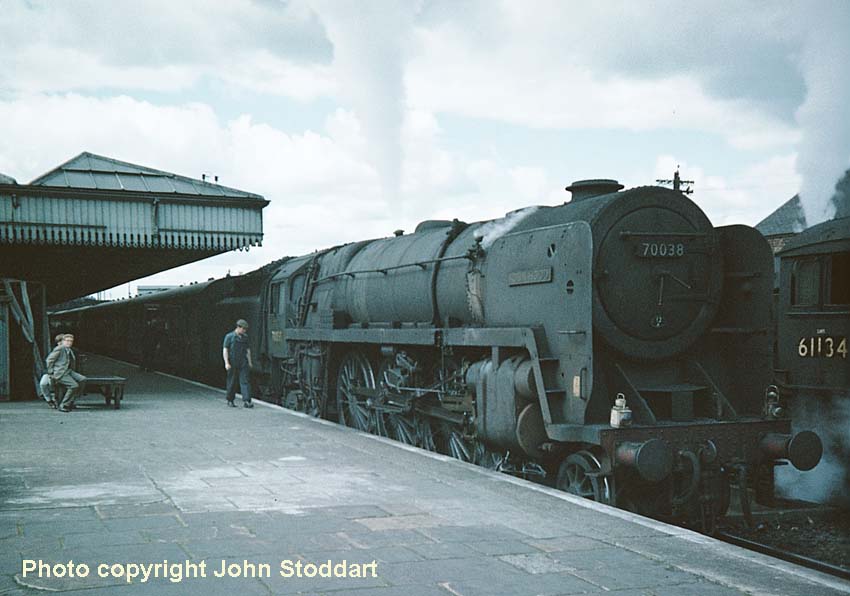
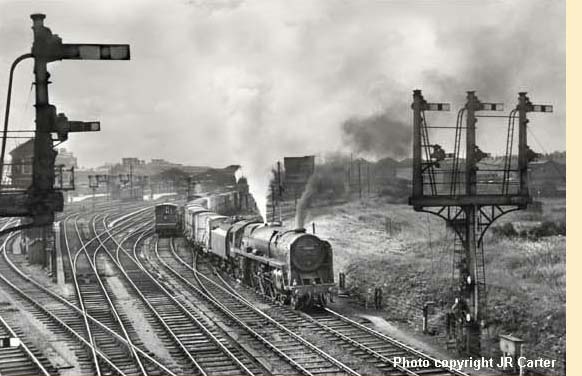 (Left) Over the a period of about 6 summer Saturdays Chester was host to a special from Cardiff often worked right through by one of their 'Brits'. Liz Taylor in decollete would not have caused a greater sensation, sweeping round the curve to the west at 3.30 in the afternoon to the babble of hordes of spotters clustered at that end of the station. Cardiff 'Brits' were invariably cleaner than our usual ones and the rail-less smoke deflectors with their brass step notches lent them an exotic aura. 70025 Western Star taking the Manchester line out of Chester. As one of the former Cardiff Brits, this engine in this location would have caused train spotting palpitations at one time. Presumably, the photo is taken after the mass move of Cardiff's engines onto the LMR. Then Cardiff and Eastern Region got rid of their Brits almost simultaneously, LMR picked them up and suddenly they were everywhere. So we got to cop them. But it was a hollow victory, as if you'd finally got a long-pursued girl to come to the pictures with you, and found she'd been with half the lads in your class.
(Left) Over the a period of about 6 summer Saturdays Chester was host to a special from Cardiff often worked right through by one of their 'Brits'. Liz Taylor in decollete would not have caused a greater sensation, sweeping round the curve to the west at 3.30 in the afternoon to the babble of hordes of spotters clustered at that end of the station. Cardiff 'Brits' were invariably cleaner than our usual ones and the rail-less smoke deflectors with their brass step notches lent them an exotic aura. 70025 Western Star taking the Manchester line out of Chester. As one of the former Cardiff Brits, this engine in this location would have caused train spotting palpitations at one time. Presumably, the photo is taken after the mass move of Cardiff's engines onto the LMR. Then Cardiff and Eastern Region got rid of their Brits almost simultaneously, LMR picked them up and suddenly they were everywhere. So we got to cop them. But it was a hollow victory, as if you'd finally got a long-pursued girl to come to the pictures with you, and found she'd been with half the lads in your class.
LAST TRAIN TO...
Towards the mid-60s, with steam disappearing fast, 'enthusiasts' specials' proliferated. At first they were beyond my means but viewing them lineside or from platforms was free, and if the straying of engines far beyond their home territory tempered their scarcity value, it was a thrill and novelty to see them. West Country pacifics at Crewe, A4s at Chester, 'Flying Scotsman' everywhere, all this helped deaden the sting of steam's disappearance.
Then I started work down in Birmingham and could afford to board as well as look at them. Their relationship to plain-jane, anonymous railway travel was about that of TV's survivor-style shows to reality. I bought tickets in response to railway magazines ads placed by organizations with names like 'Stanier Black 5 With Skefko Bearings, Caprotti Valve Gear and 3500 Gallon Tender Preservation Society'. I jumped at the chance to say, 'Farewell to the Gurbling-Under-Burdock branch line' even though I had look at a map to find out where Gurbling-Under-Burdock was. I was a puppet dancing to that medley of collection-mania and nostalgia that is at the core of a spotter's psyche.
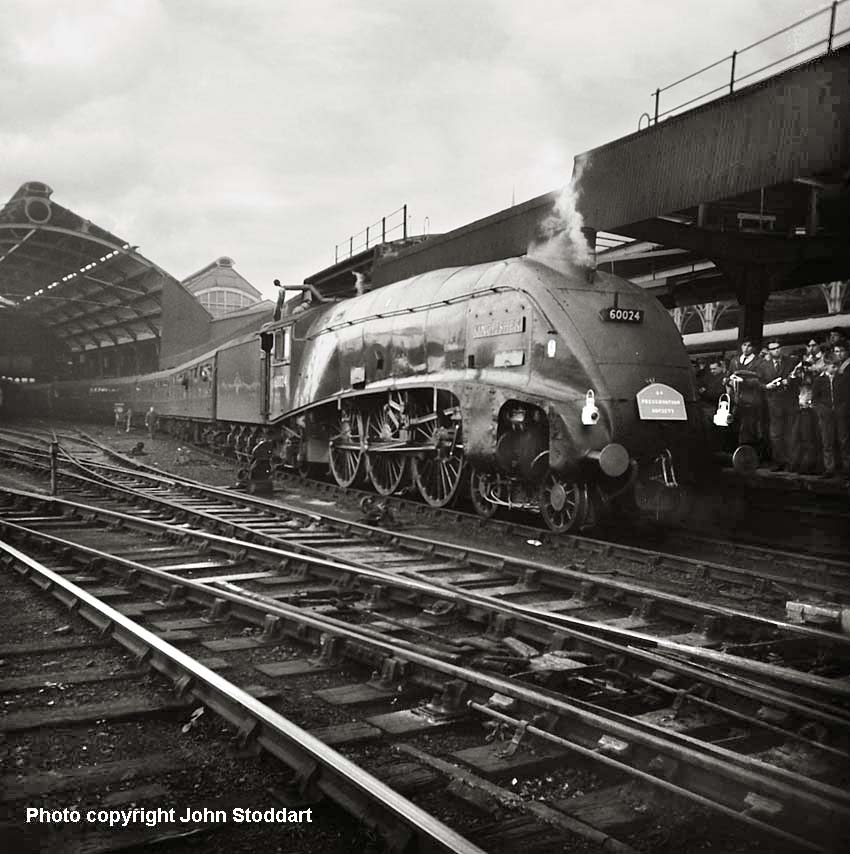
(Above) 60024 Kingfisher at Newcastle with an A4 Preservation Society Special from Doncaster, 1965 or 66. I am one of two trillion photographers taking this very same picture.
So I travelled the length and breadth of the country, finding myself looking for the first and last time at stations and engines I'd never seen before and haven't since. On board these last-chance cavalcades rows of drab-looking men in raincoats sat facing eachother in silence, like government clerks on the 5p.m. back to Hemel Hempstead or fans bound for a National Dominoes Tournament, perhaps first line supervisors en route to a Shoelace Manufacturer's Convention. At designated photo stops they morphed into kindergarten lunatics, jostling each other along and off platforms to take identical pictures of the same locomotive. At that age I had neither the confidence nor the gift of self-analysis to realize and accept that these events weren't my cup of tea. My love for railways wasn't as simple as I had thought. It wasn't a love of steam, or trains, or railway practice. It was love of a particular time and place, its ambience and relationship to a point in my life. It was like the view from a train window: there for a while, now behind, now gone and never to be recaptured exactly as it was. I realized it was time to close the book and consign the best bits to memory.
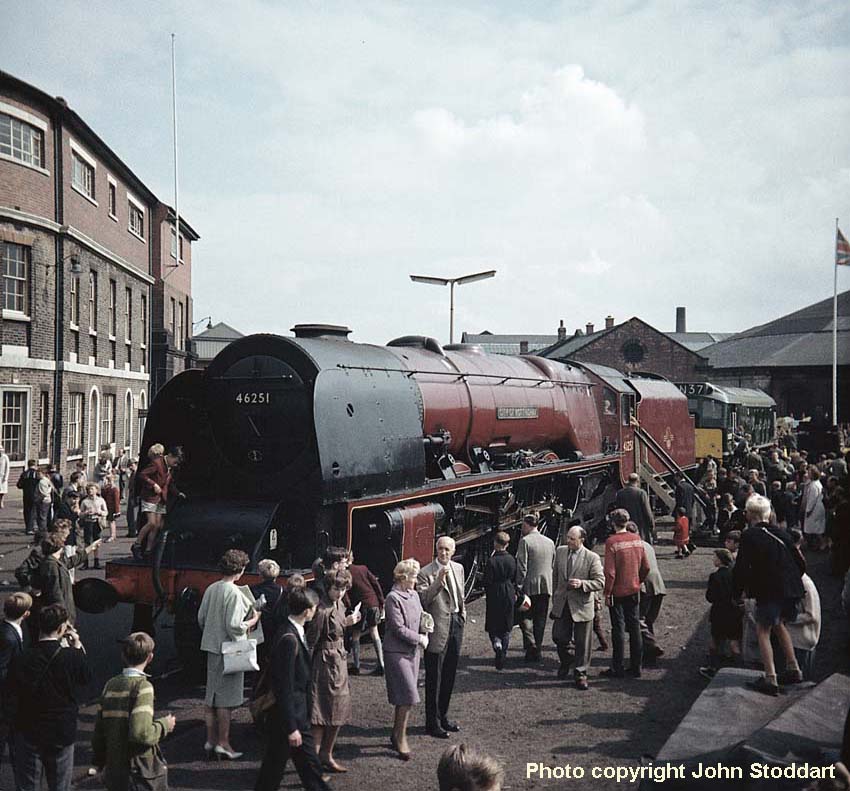
(Above-Below) Not 'enthusiasts specials' but their close cousin. Derby Works Open Day in the early 60s, engines like tailors' dummies, crowds of people. I now find these pictures as interesting for the people as the locomotives. The kid in front of D57 is wearing typical spotter garb of that era, complete with combine stuffed into his back pocket. All that's missing is the duffle bag.
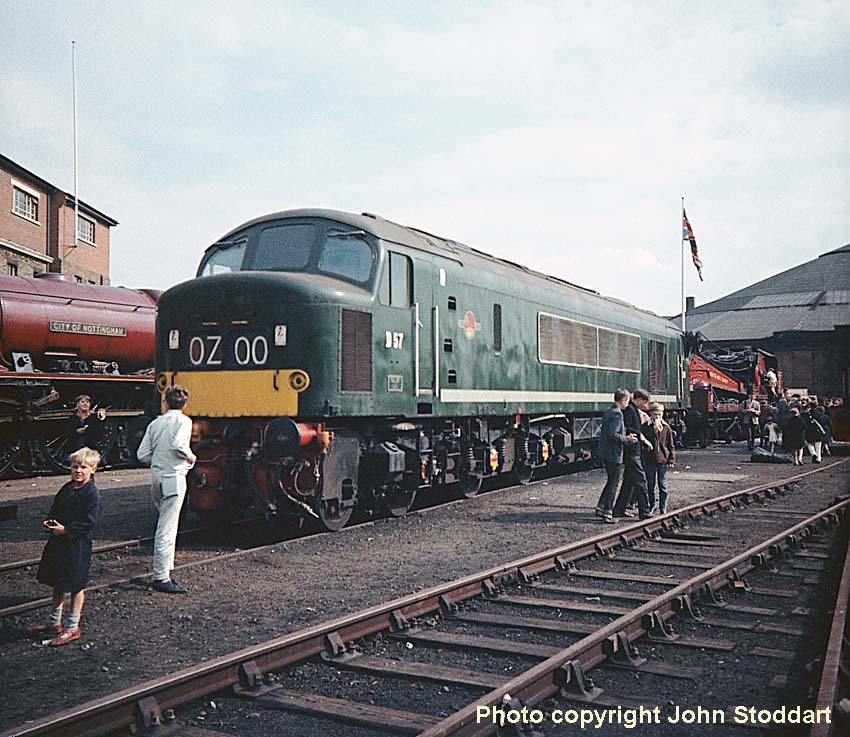
At age 18 I left school and went to work in Birmingham. These were the last years of steam in Britain and my contact with my old passion was limited to one final, sad trip to Scotland, watching some heavy goods workings around Wednesbury when I took the train there for evening school on Thursday evenings, and participation in a few 'last chance' specials. A 'Farwell to the Former Great Western Railway Line Birmingham-Chester' railtour on March 5 1967, gave me the opportunity to take one last look at something that had been a major part of my life and I was able to hang around Tysley watching 'Clun Castle' being steamed up for various events. At the time of writing this I'm still looking for my photos from those years.
Happily I was too preoccupied with other things to let the decline of steam eat at me; like, how to get out of Birmingham and the numbingly boring job I was doing. Nevertheless, I had to witness this heartbreaking moment below...in befittingly funereal weather, 46235 City of Birmingham, withdrawn from service November of 1964, is laid to rest in a museum in its namesake city.
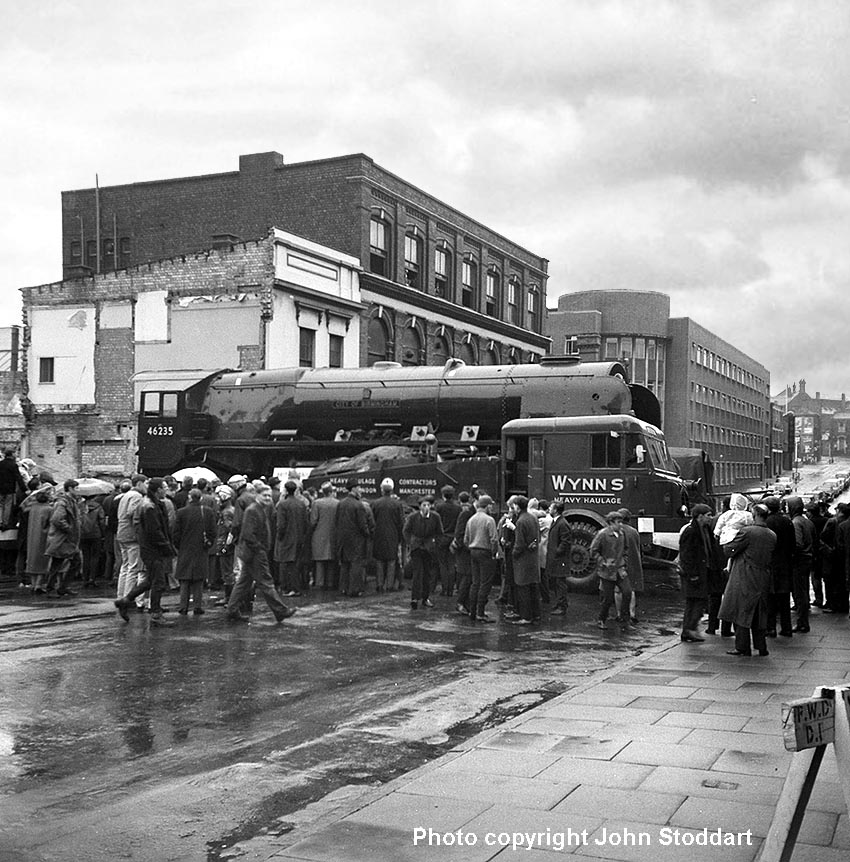
WORKING THE REFRESHMENT TROLLEYS AT CHESTER GENERAL
In the early 60s I got a summer job in the refreshment services at Chester General. Over my working life it was the first of two opportunities I had to combine a hobby with the mundane process of earning a living, and this time it turned out spectacularly well. Sometimes I had to work in the buffet itself but most of the time I was one of four lads selling off refreshment trolleys on the platforms. I could pause here for five minutes of music-hall jokes about B.R. sandwiches, but in all honesty they were the nearest anything on my trolley came to edibility. Made every morning from quality ham and fresh bread with real butter, what they lacked in imagination they made up for in wholesomeness. Which is more than can be said for the sweets, chocolate and Gala Fruit Pies that made up the balance of my cargo. Plus a gasometer-sized container of tea. As you would expect, this was only drinkable for the first hour after brewing, after which I was hopefully ready for a refill. Otherwise I prayed the train I was serving would be whistled out promptly. Some people on holiday extras pulling into platforms 8 or 10, perhaps old customers of mine, figured the product available at the buffet adjacent to those platforms would be a better bet. I suppose I should have warned them of the risk but I doubt they would have listened and besides, why spoil a good show? The sight of shirtsleeved, teacup-loaded men issuing from the buffet in time to witness the tail-lights of their train disappearing towards Llandudno, lightened the dullest day.
We were booked to work from about 8.30 to 4.30 or 5, but so much did I enjoy the work that I would often stay to eight in the evening, crossing from one side of the station to the other to meet trains headed up towards Holyhead or back to London, Manchester, Birmingham, you name it. On a summer Saturday the procession was endless, and endlessly varied.
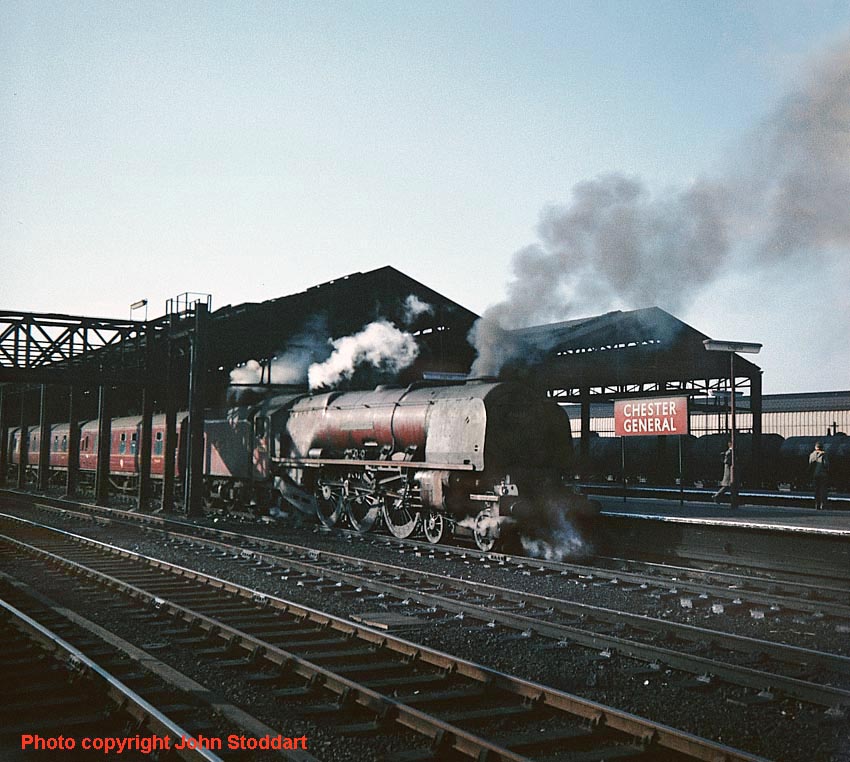
(Above-Below) One of the star turns at Chester was the late afternoon express that left Bangor for London at 12.30. It was usually worked from Chester onwards by a Pacific that had come down from Crewe earlier in the day. For me this picture epitomizes those late summer afternoons when I used to work the refreshment trolleys on the station. 46229 Duchess of Hamilton awaits the right away. (Below) Trainspotters congregated at the west end of Chester General. There you could catch most of the worthwhile GWR and LMR traffic. But photographic opportunities were better at the east end. From its number, the date of this photo (summer of '62 I think) and the condition of the loco, this EE Type 4 might have been not long out of the box. Starting south, or east if you will, from Chester with a London train.

It was here that I met Chris, my partner on that first Scotland trip in 1964 (see previous page). He was designated to travel the trains with his trolley, a kind of Lone Ranger to us small-town sheriffs. There were rules. He was to stay clear of trains manned by the Manchester refreshment men, and those with restaurant cars. Rules, to Chris, carried less force than mild suggestions or hints. He was the buccaneer of railway refreshments. If he wanted to work a train already boarded by a Manchester man, he would do a quick calculation of the travel time to the next stop, identify his competitor's location, and board the train far enough away to give him a decent haul of customers without being discovered before jettisoning. That was the theory anyway. More than once the tortured sound of trolley wheels well over their speed limit preceded the bulldozing of the buffet's double doors that announced Chris's flight for asylum, pursued by an irate Manchester refreshment vendor. Letters and phone calls of complaint to Mrs. Edwards, the refreshment services manageress, were legion.
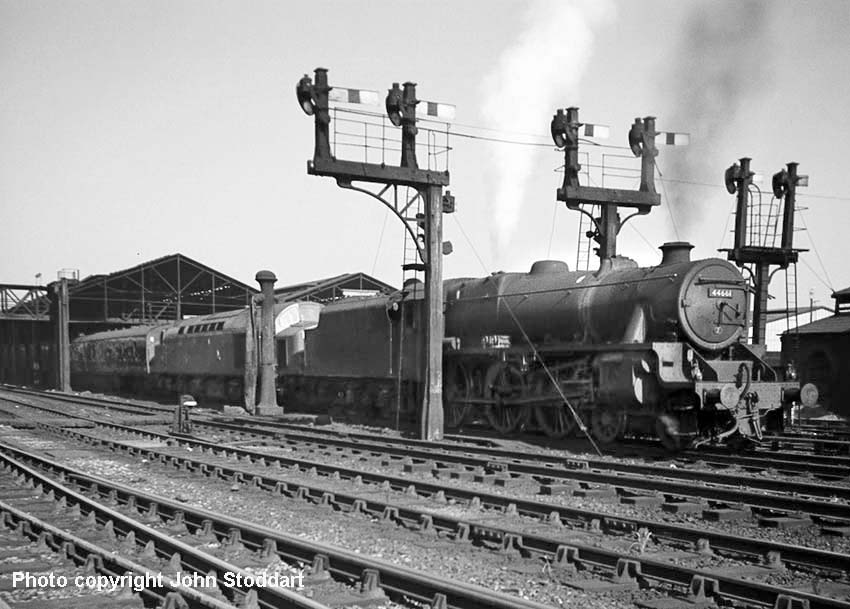
(Above) Black 5 44661 helps an unidentified EE Type 4 take a train from the North Wales Coast out of Chester to Crewe. I had always thought railway workings were highly structured, everything preordained. But, especially on summer weekends, this turned out not to be so. With all kinds of equipment pressed into service, specials arriving from every direction, anything could happen. I recall a station inspector just about filling his pants one damp Saturday afternoon when a Jub and Mickey showed up double-heading a coast-bound train into platform 10. "What the ***!!!!," he yelled, then to the driver of the pilot, "You! Get off to the shed!" Obviously something or other was not according to Hoyle.
As I found out later in Scotland, nothing pleased Chris more than making tight connections, impossible ones even better. Piloting his trolley through a train like a Roman Charioteer, he was able to clean out a ten-coach rake inside one or two stops. Photographic retention of the timetable had already laid out for him the departure times of all trains headed in the opposite direction, and Chris had targeted his next payload. That would often mean a frantic switching of platforms, trolley and all, at stations with neither lift nor track-level crossing. Spittle and hair flying, he would burst from his inbound train yelling to railway staff to hold the one outbound at the platform across the tracks while he manhandled his refreshments over a footbridge. One he dropped the whole lot on the ballast. Like most self-obsessed and driven people, he was oblivious to the wake he left behind him, and flabbergasted when it occasioned a strong reaction. "Flewitt threatened to hit me!" he complained to me once, eyes wide with disbelief and injury. Flewitt was Mrs. Edwards' assistant, a tall, grim ogre of a man, who shared none of her half-concealed admiration for 'The Big Noise from Bebbington' and amused tolerance for his escapades. I often wonder what became of him. Chris, if you ever read this, please don't tell me you became a civil servant, married and had 2.3 kids. I couldn't stand it.
Mrs. Edwards' assistant, a tall, grim ogre of a man, who shared none of her half-concealed admiration for 'The Big Noise from Bebbington' and amused tolerance for his escapades. I often wonder what became of him. Chris, if you ever read this, please don't tell me you became a civil servant, married and had 2.3 kids. I couldn't stand it.
(Left) Black 5 and Brush Type 4 pass Chester's Roodee racecourse and cross the Dee bridge. This is the second bridge, the first having collapsed back in 1847 - one of Robert Stephenson's less celebrated engineering feats. It was rumoured that restrictions on this bridge kept GWR Kings out of Chester.
(Below) A common scene but a not-so-common engine. This is one of my very few pictures taken at the west end of Chester General, the normal spotting end. Those who didn't want-couldn't afford a platform ticket would spot from the goods road behind the coal wagon in the background, or from Hoole Bridge steps directly behind the photographer. The engine is 5002 Ludlow Castle, a Swindon locomotive and a rare visitor to our part of the world. Our usual 'Castles' were Wolverhampton or Shrewsbury based, like 5070 Sir Daniel Gooch and 5097 Sarum Castle. I always thought the Castles were amongst the most handsome steam engines and, alongside the toy-like Manors, my favourite GWR class - even in a filthy condition.

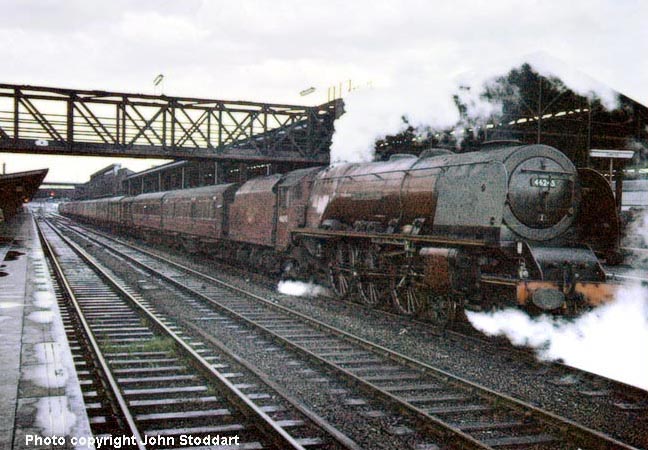
(Above) 46245 City of London, unmistakably red, appears to be passing non-stop through Chester General here, possibly with up empty stock since I can recall very few passenger trains, apart from holiday camp specials for the coast, working non-stop through the station.
Perhaps the highlight of my part-time career at Chester refreshments came later, in my last year at school, when I was called in to work an off-season special to Stratford on Avon. With Flewitt, I was to man a mini buffet in a twelve-coach train full of fifth form schoolgirls off to see a performance of King Lear. Aside from the guard, driver, fireman and Flewitt, who looked like an oversized Ben Kingsley after a bad night on the bottle, I was the only male. Never have I been the target of so attention and flirtation, even in later years when I worked summers as a lifeguard at a local pool. We were hauled there and back by a Brit, but I can't remember which one. I was too busy posing and posturing.
Many years later, during a rare visit to Chester, I sat on a bench alongside platform 8 at Chester General, the station now a ghost of its former self. There seemed to be no connection to my summer workplace of the early to mid-60s. Hardly anything moved. The few trains that slid in were stunted, headless versions of those I had known way back. Could this four-coach runabout actually be a Manchester-Llandudno affair? Then there was the sudden metallic slide and crash of lift doors, the lift I used a thousand times to cross the tracks with my trolley, and I was instantly back in 1964. A young girl stepped away from the phone kiosk the other end of my bench, and timidly asked if I had a pen she could borrow for a minute to take down some message, perhaps a phone number she had just been given. Here, have the pen I said - at work, I had drawers-full of them, promo gifts from clients and suppliers. She looked at me strange, stuttered no thanks, and gave it back to me. It was not 1964. I was just an old man, frightening a young lady by offering her a gift.
(Below) D222 parked under the old Hoole Street entrance. Probably taken in the late 60s or early 70s not long before I left the UK. The footbridge has long gone, as has almost everything in this photo except the rain.

LNER PACIFICS
By the early 60s we could see every class of LMR and WR engine in Chester except 'Kings'. No Southern Region engines of any description, but that didn't bother me. Southern Region was tinny engines going piddly distances to my way of thinking. The old LNER was a whole different story. Aside from the occasional B1 - surely one of the ugliest engines ever to turn a wheel on British railways - and something equally nondescript drifting into Chester Northgate (over which the LNER had traditional running rights), few North Eastern Region locos showed up in our area. To a growing trainspotter, this was unacceptable. NER had some of the most famous, best-looking, most exotic locomotives in the world. I had to go see some.
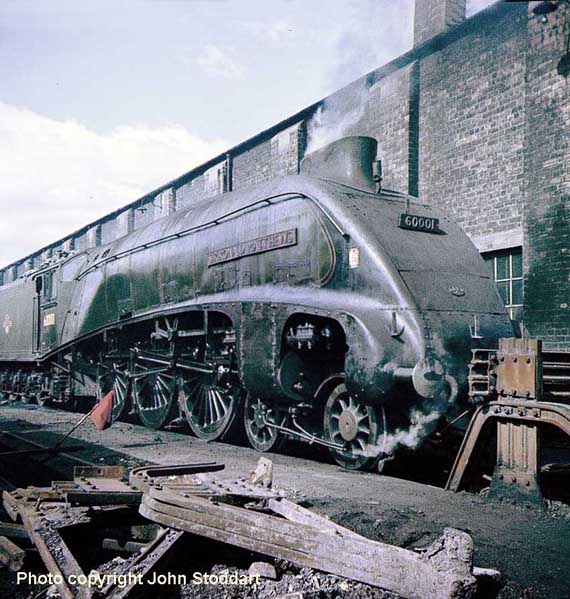
(Above-Below) This picture mystifies me. As far as I can recall, I only saw 60001 Sir Ronald Matthews once, at Doncaster Plant. The building behind looks right. Yet I'm positive I didn't have a camera at that time. So this is probably at Edinburgh, St. Margarets or Haymarket. (Below) 60052 Prince Palatine at Aberdeen. Sadly, one of my very few photographs of my favourite class of locomotive and looking a little worse-for-wear.

In particular, I had to see those amazing A4s and, my all-time favourite engine, the A3 with - wait for it - 'jerry blinkers'. I just could not agree, still can't, with those who said 'jerry blinkers' ruined the look of the A3. For me, they transformed a slightly old-fashioned looking lady into something rather racy, one of those older women who render a teenage boy dry-mouthed and sweaty-palmed. A3s had it all; a history of impressive performance, great looks, and the best names. Those names, 'Blink Bonny', 'Tagalie', 'Shotover', 'Galtee More', told you LNER men could see into the soul of a steam engine. To see any North Eastern Pacifics I would have to travel further than I had ever gone in my train spotting life. Short of cash, Leeds was the cheapest day-return likely to produce the goods and on a busy day during which I 'bunked' both Holbeck and Neville Hill, I did see my first NER pacifics. But they were A1s, much better than nothing but still leaving me feeling a bit short-changed.
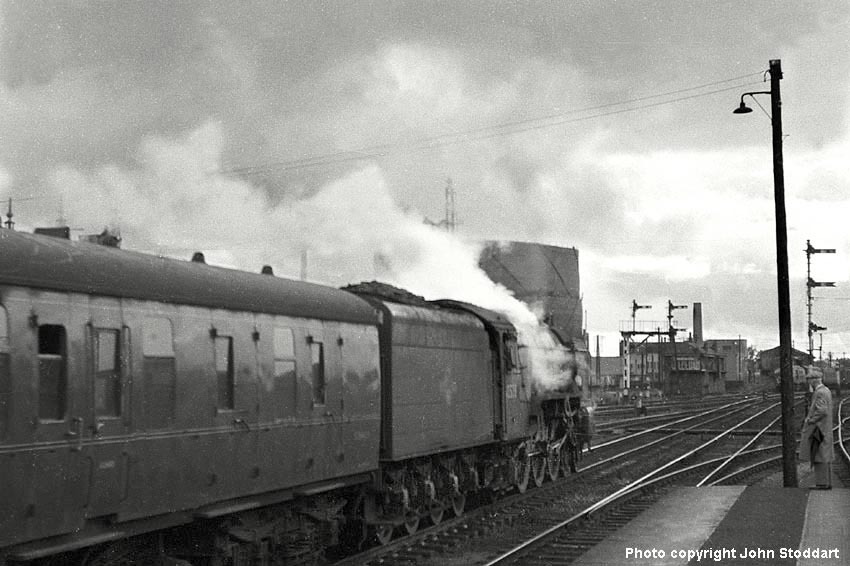
(Above-Below) The A1s were my least-favourite LNER pacifics, A2s a cut above. I particularly liked A2 names, illustrious ones like 'Cock o' the North' and a good mix of famous race horses. 60528 Owen Tudor heads south out of Stirling with an evening train for Glasgow. (Below) 60532 Blue Peter poses here at Perth shed.

One leg further than Leeds, but still reachable on a reasonable day-return ticket, was York. It was there, at 50A, I saw my first A3s, 'Spearmint', 'Ladas' and 'Minoru'. Beautifully turned-out, wearing their lined green and black like royalty, brass names glittering, they fulfilled all expectations. But I returned to the station A4-less and an hour away from having to catch my train home. It was while I was crossing one of the station footbridges that I heard an odd sound, the kind of half-cheering/half screaming noise over-excited schoolboys make, against the most peculiar background, a kind of hollow hushing. I turned and started to run towards the din just as the unmistakable coxcomb of an A4 chimney glided past the footbridge deck. 60013 'Dominion of New Zealand' on a down train. It is one of a dozen or so indelible train spotting memories, my first A4. Over the next couple of years I was to cop the whole class, 16 of them one unforgettable summer Saturday in Doncaster at the station, shed and Plant. I was to ride behind them many times on the Glasgow-Aberdeen three hour expresses and special trains. From any angle, they were fascinating engines and the thrill of seeing one never lessened.
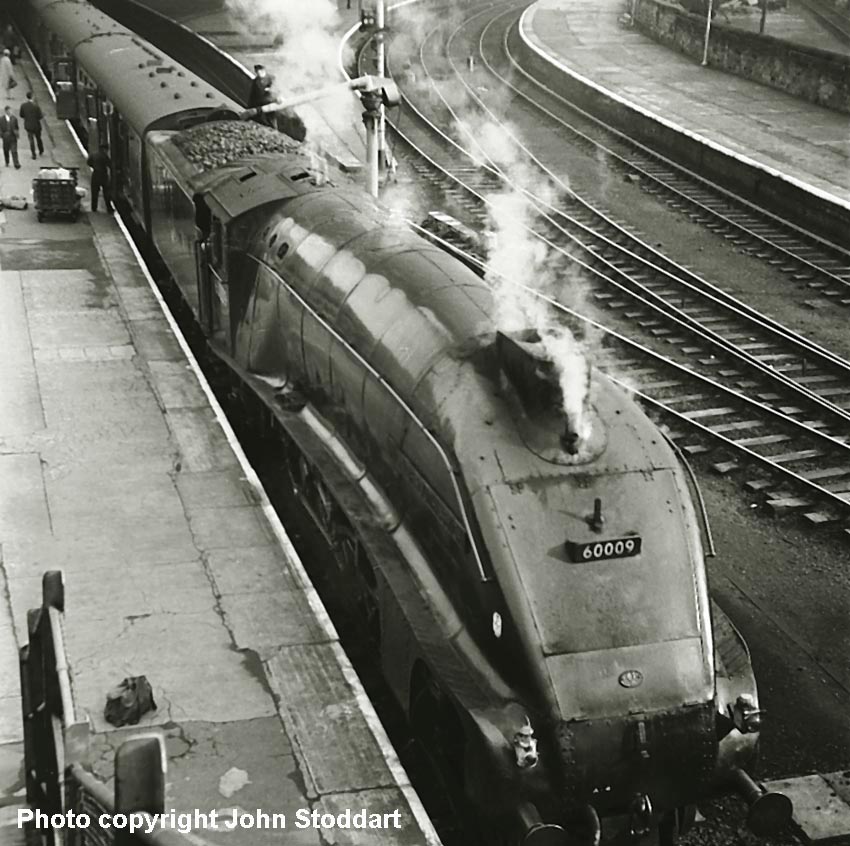
(Above-Below) Catching the eye from any angle. 60009 Union of
South Africa at Perth, 60031 Golden Plover heading south from Perth.
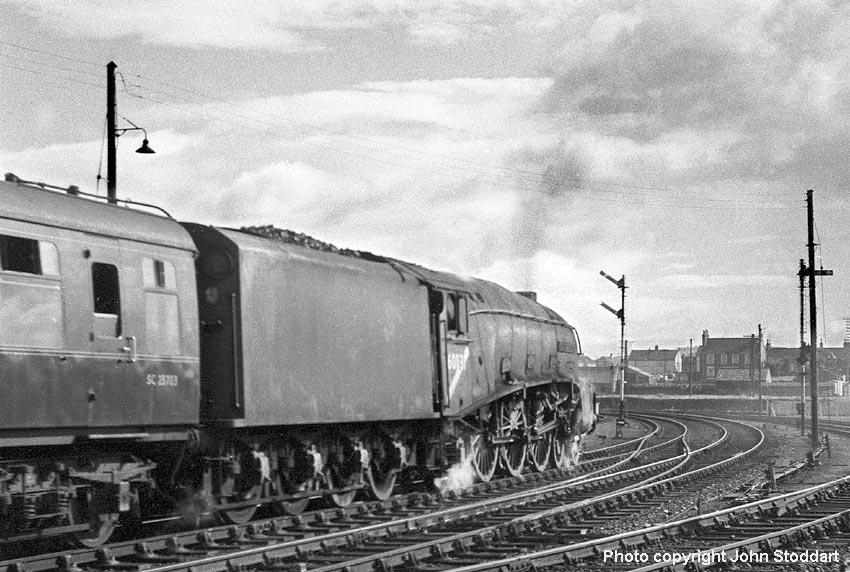
MOUNTAINS AND HUDSON
Steam in Canada.
I escaped from Birmingham and the desiccating effects of office work by going to Liverpool University for 5 years to take a BA and MBA consecutively. Happy years, particularly the first three. But by the spring of 1972, pending decisions, until now vibrations on a rail, took on the clamour of an onrushing express. In a few months I would have to leave school and earn a living.
Return to Birmingham was out of the question. However, most of the jobs I wanted were based either there or in London. Early in the summer of 1972 I visited a friend who had graduated the year before, married and found work in London. He lived near Upminster, in a suburb that was the prototype for the opening scenes of Fall and Rise of Reginald Perrin. Every seven minutes electric trains rattled like computer printout past the bottom of his garden. He took one of them at 7.30, five days a week, into London and another one back at 5.30. Living there for the last nine months, he had yet to exchange words with either neighbour. Walking past nearby houses, the only indication that any were inhabited was the occasional sign in a garden advertising "Second Prize, Hybrid Tea, East Dunwoody Rose Society". It was a freezing summer, the second in succession. On no day, in the northwest at any rate, could you chance going out without a jacket. I decided to emigrate.
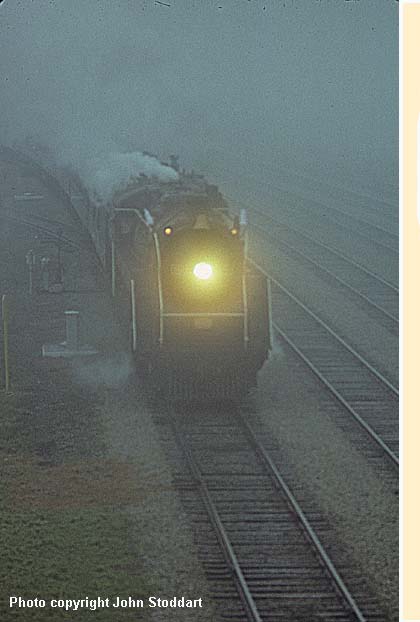 Early one midsummer Sunday morning in 1975 I was out with my new girlfriend driving through a deserted downtown Toronto going nowhere in particular, as people worldwide do on Sundays. It was one of those opaque, southern Ontario summer days. Air, land and water had the same colour and consistency, overused dishwater not quite gone cold.
Early one midsummer Sunday morning in 1975 I was out with my new girlfriend driving through a deserted downtown Toronto going nowhere in particular, as people worldwide do on Sundays. It was one of those opaque, southern Ontario summer days. Air, land and water had the same colour and consistency, overused dishwater not quite gone cold.
Driving down Spadina Avenue across the tracks at the west end of Union Station, my heart jack-knifed. Leeching into the Lakeshore mists, a column of steam mounted and moved towards us like a prairie twister. I threw the car into a U turn across six, fortunately empty, lanes and mounted the sidewalk with my four-way flashers going, feeling behind me with my free hand for my camera.
Across the railyard CN 6060 was marshalling cars for a special train bound, we subsequently found out, for Orillia, 70 miles north . There was an immediate choice to be made: do I tell this girl, who up until now probably thought I was normal, that I was, or am, potty about steam locomotives? Like former wives and girl friends, it seemed to be one of those subjects you just don't discuss with a woman until the relationship is on an unshakeable footing. In all honesty I can't recall how I phrased the confession, but these pictures prove we spent the rest of the day chasing around southwest Ontario. It didn't jeopardize the relationship. Maybe it even helped, spiced up an otherwise-bland character. Because the girl became, and still is 34 years later, my wife (Above) 6060 marshals its train in Toronto's Union Station yards.

(Above-Below) 'Bullet-nose Betty' 6060 preparing to return to Toronto from Orillia, summer 1975. Train spotters, or whatever fancy name you want to give them, have much in common the world over. There is nothing quite like getting up close and personal with a steam engine, to get your heart thumping. For the technically-inclined, a few notes about 6060: Built at Montreal Locomotive Works in 1944. Length is 93 feet, height 15 feet 1 ½ inches. Operating weight 637,540 lbs., tractive effort 52,500 lbs. (no booster). Driving wheel diameter 73 inches. Operating pressure 260 psi. Fuel is light crude oil, converted from coal. Tender capacity is 5,000 imperial gallons oil and 11,000 imperial gallons water. One engine of this class ran 18,353 miles in one month. (Below) Terence Cuneo meets Norman Rockwell. 6060 disturbs Orillia's Sunday snooze and gives local fishermen something to shout about.
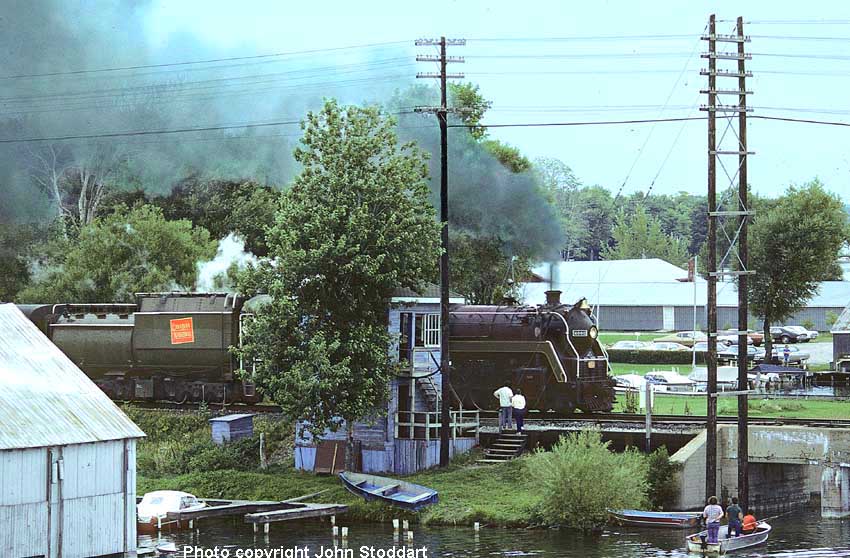
Sheer coincidence found me a home for the past 30 years overlooking what used to be the British Columbia Railway main line from Vancouver to Prince George, 470 rail miles north. From about May to September, right up to the late 1990s BCR ran a regular steam excursion from North Vancouver to Squamish, a distance of about 40 miles through spectacular scenery. Most of the time Royal Hudson 4-6-4 2860 provided the motive power. Not the most beautiful steam engine I have ever seen, 2860 was still handsome enough to rubbish the preconception I had, coming from the UK, that all North American engines were utilitarian-ugly.

(Above) 2860 was built at Montreal Locomotive works in June 1940. It weighs 648,500 lbs., steam pressure is 275psi, driving wheels 75 inches, tractive effort 42,250 lbs. Length 90ft 10 inches, height 15 feet 10 inches. There are two cylinders, 22" diameter, 30" stroke. Here, 2860 bursts out of the tunnel at Tunnel Point. One of the disadvantages newer countries face is that everything has to be named in a hurry, and imagination is in short supply. It's either native Indian or stunningly obvious for placenames along the line. After this the train will pass Windy Point whose main feature is …
There are two cylinders, 22" diameter, 30" stroke. Here, 2860 bursts out of the tunnel at Tunnel Point. One of the disadvantages newer countries face is that everything has to be named in a hurry, and imagination is in short supply. It's either native Indian or stunningly obvious for placenames along the line. After this the train will pass Windy Point whose main feature is …
(Right) A murky west coast morning. Nearing its 8 o' clock departure time from North Vancouver station, 2860 eyes up a younger product of Montreal Locomotive Works, 3000hp M630 No 721…and then 2860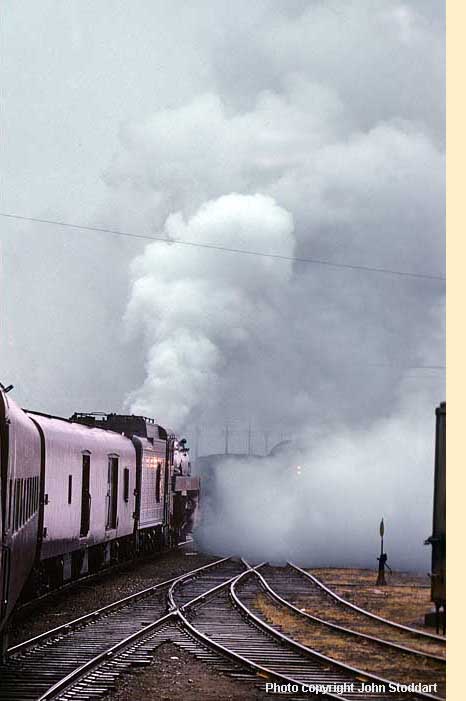 decides to speak, opens its cylinder cocks (left) and gets under way for Squamish...
decides to speak, opens its cylinder cocks (left) and gets under way for Squamish...
(Below-Right) Crossing the Capilano River at the western boundary of North Vancouver. From here to Squamish it's mostly single track with plenty of unmanned crossings. Over a very sinuous route, speed will seldom get much above 40 mph, yet level crossing collisions are not uncommon. The average person's grasp of the laws of physics and their application to hundreds of tons of locomotive hauling thousands of tons of train, is poor. The only time I heard of a near-equal outcome was in the Fort Nelson division of BCR in the late 90s, when a fully-loaded logging truck tried to beat a double-headed logging train to a crossing. It was a tie. Both locomotives were knocked off the rails, the truck was totalled, there were logs everywhere.
were logs everywhere.
Later in my career I took a job with the British Columbia Railway. What started as a rewarding experience in every sense gradually turned into one of disillusionment. This is not the place to go into details. I'll just say that I found a workforce, both union and management, in which some people literally worked themselves to death while others got through the day with a minimum of effort and the sole goal of getting home to watch TV, generated a poisonous and dispiriting atmosphere. One union official boasted he would shut down the railway before he was done. As I write this, his target has been all but realized. Whole divisions were closed before the company was sold to CN, whose probable main aim was to take a competitor out of the market. Where, 10 years ago, kilometre-long trains rumbled by my house through the day and night and the line boasted a passenger train regularly appearing in worldwide "Top 10 Railway Journeys" lists, today the odd 20-30 car train puts in an infrequent appearance. All indications are that CN will close most or all of the line as soon as it legally can, and those employees dying to get home to the TV can watch it full-time. Their kids will have missed the opportunity to play their part in a potentially vibrant and productive organization. They may find world-enriching employment in pursuits with titles like "Personal Wellbeing Consultant", "Lifestyle Counsellor", "Young Canine Obedience Coach" and "Assistant Government Supervisory Administrator". As meaningful jobs evaporate, those whose purported functions take longer to describe than execute, multiply.
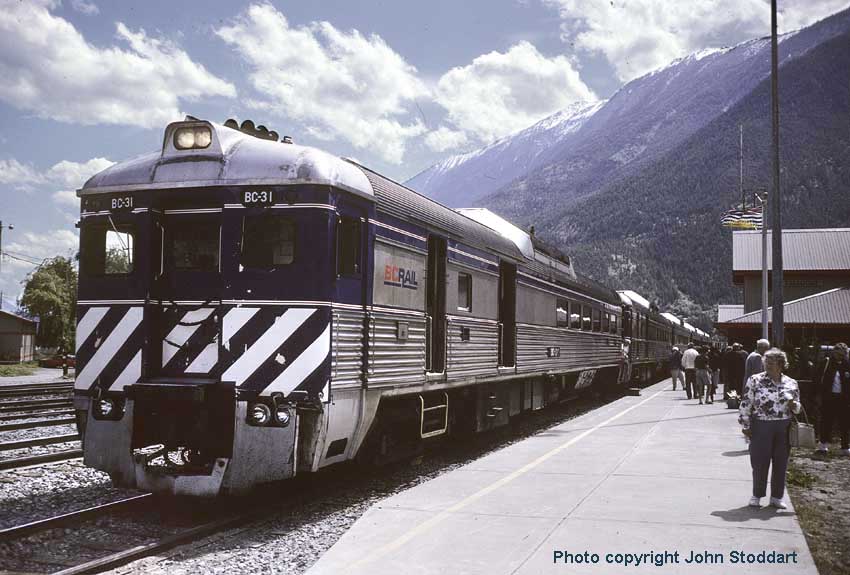
(Above) For years the daily Bud Car from North Vancouver to Prince George figured in most top ten lists of Great Railway Journeys. It was dirt cheap, generally empty, and lived up to its reputation. People now spend quadruple its fare to travel one tenth of its journey along the first 40 miles of the same route. I took it once, experiencing the heady thrill of being able to walk down the hill 200 metres from my house with a light bag over my shoulder, stick out my hand at the crossing to flag it down, and spend that night in a hotel 470 miles north of here. All told, it is the most spectacular railway journey I have ever taken.
The south end of the ex-BCR main line is at roughly the same latitude as Paris, the northern limit at about Stockholm's latitude except you're hundreds of kilometres inland so there is no sea influence. Just south of the Yukon border, it is rough country with long and very cold winters. There are more bears than people. Like people, animals love the path of least resistance and in winter, that's the railway line. No moose in his or her right mind is going to struggle through snowdrifts all day when there's a nice, level ploughed route available. Unfortunately, like their two-legged cousins few of them appreciate the laws of physics and through the winter, many moose are hit. However, if you live up there, chances are you're a hunter, the old-fashioned kind who butchers and eats what he kills. It was not unknown, though officially frowned upon, for the Fort Nelson freight to arrive in the yard with a dead moose tied across the front of the locomotive.
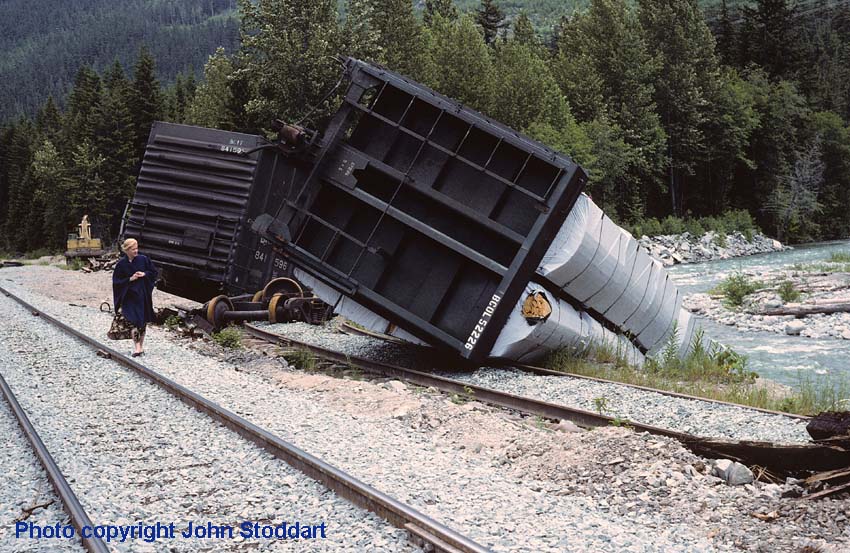
(Above) Few of them would admit it, but disasters are to a railwaymen what adultery is to a gossip columnist. I have witnessed men who would rather chew broken glass than apply an ounce of enthusiasm to their day job, gleefully rise unsteadily from a table full of beer in response to an emergency call to spend 72 hours with little or no sleep, performing the labours of Hercules to re-open a line. There were many derailments when I worked at BCR, a good portion of them in the 60 mile section between Squamish and Pemberton where the terrain is especially difficult. The line follows the Cheakamus River for much of that section and unfortunately that's where the derailed cars usually end up. As here, where two cars of pulp are nose-down in the Cheakamus north of Whistler. Since the line has been cleared, they'll probably be there a while. The rather over-dressed lady wringing her hands over them is my wife, who probably wasn't told we would be spending part of the day scrambling around derailed railcars. I would not be surprised if 'environmental sensitivity' is cited by CN as a reason for eventually closing this section. They have had a couple of very costly derailments here since taking over the line, and have been fined heavily for polluting the river. The most inept accountant would have no trouble demonstrating lack of economic viability for this section of the line.
Sadly I didn't realize it at the time, but the late-80s were something of a swansong for steam on Canada's west coast. Dovetailing with Expo 86 in Vancouver, there was a Steam Expo tagged as 'the largest gathering of steam locomotives since the 1948 Chicago Rail Fair.' Amongst other things it featured my old friend from Toronto, CN 6060, which hung around the area, on and off until the late summer of 1988 when it double-headed our daily North Vancouver-Squamish tourist train with local star, CP 2860.
Tootling along a snaking, water-level 60-or-so kilometers of line at 40 to 70 kph, these engines couldn't begin to demonstrate their capabilities. Regardless there's something soul-stirring about 574 tons of steam power, 184 feet from the front buffer of the pilot to the rear of the train-engine tender, in motion. With a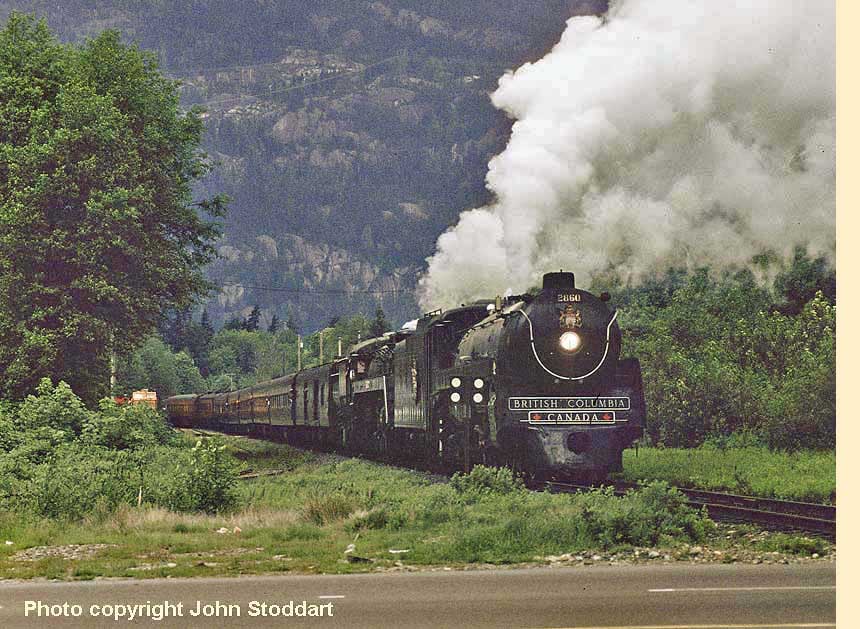 crystal ball handy I would have stirred myself to spend every daylight hour of the week these engines operated, watching them in action. But at the time it seemed these heady days would go on forever. If only I'd known. 6060 is now largely confined to a short stretch of line in Stettler, Alberta. In the spring of 1999 a pre-season inspection of 2860 revealed serious leaks in the superheater elements and the need for major boiler work. She was taken out of service and parked in Squamish. Years of hard work by volunteers resulted in a last gasp on December 9th, 2010 when I was startled out of my wits by a call from my subconscious, the sound of 2860's whistle coming out of the December rainmist on the line below my house. She ran light engine to North Vancouver, returning with a special that evening. And that was it. At an estimated $1 million to get her back into full, certified, working shape we're not likely to see her again on special duty for the foreseeable future.
crystal ball handy I would have stirred myself to spend every daylight hour of the week these engines operated, watching them in action. But at the time it seemed these heady days would go on forever. If only I'd known. 6060 is now largely confined to a short stretch of line in Stettler, Alberta. In the spring of 1999 a pre-season inspection of 2860 revealed serious leaks in the superheater elements and the need for major boiler work. She was taken out of service and parked in Squamish. Years of hard work by volunteers resulted in a last gasp on December 9th, 2010 when I was startled out of my wits by a call from my subconscious, the sound of 2860's whistle coming out of the December rainmist on the line below my house. She ran light engine to North Vancouver, returning with a special that evening. And that was it. At an estimated $1 million to get her back into full, certified, working shape we're not likely to see her again on special duty for the foreseeable future.
These pictures hopefully capture something of those fading late summer days in 1988. The double-header is shown in Squamish poised for the southbound return; leaving for North Vancouver; and I have others passing Porteau Cove where road and rail-line elbow each other for space between cliffs and sea. Composition of the admiring group (below) around the engines in Squamish is internationally recognizable: a single poor lady amongst a gaggle of middle-aged men, one of whom is desperately pleading to 'cab' 2860.
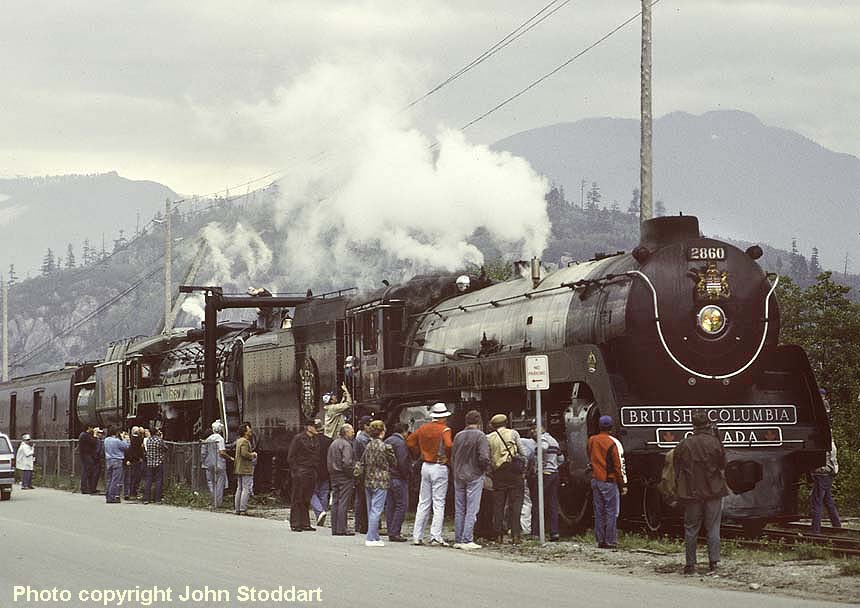
Anybody reading this article will have gathered I'm not a huge fan of the railway special and preserved line experience. It's far better than nothing but can hardly hope to replicate the complete ambience of steam-powered railways in their zenith. Nevertheless I did enjoy a day on the Langollen Railway during a trip to the UK in the late 90s, walking on cinders between sleeping engines (yes, I bunked the shed), the smell of hot oil and coal, hearing again the slam of carriage doors before train departure. This picture at Langollen station isn't your standard three-quarter shot but for me it reawakens something of the feel of a working railway, the relationship between man and machine.
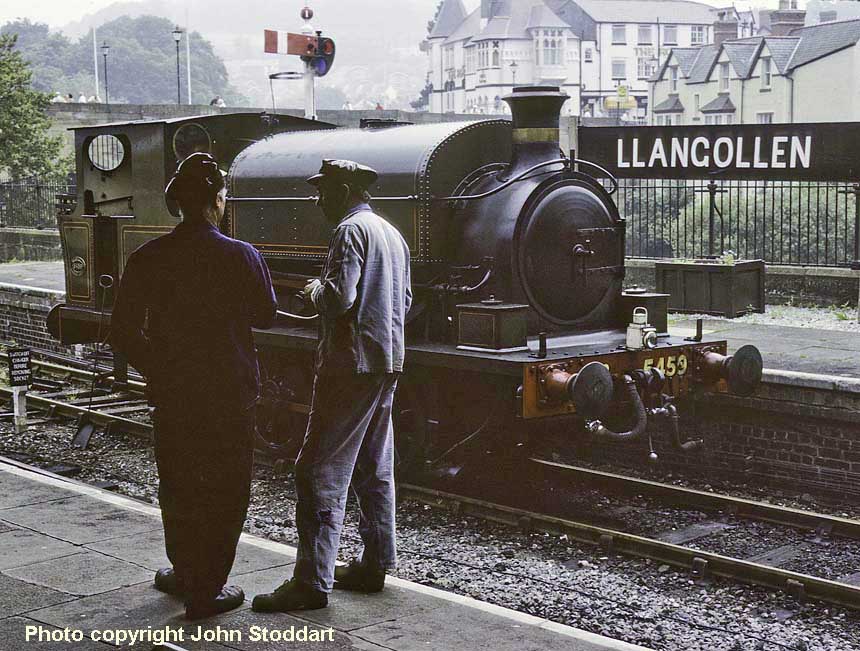
(Below) Let's close on a dreamier note. This photo gives some idea of the scale and difficulty of the BCR Vancouver-Whistler section. Royal Hudson 2860 weaves its way along Howe Sound just south of Porteau. Click on photo to enlarge even more...
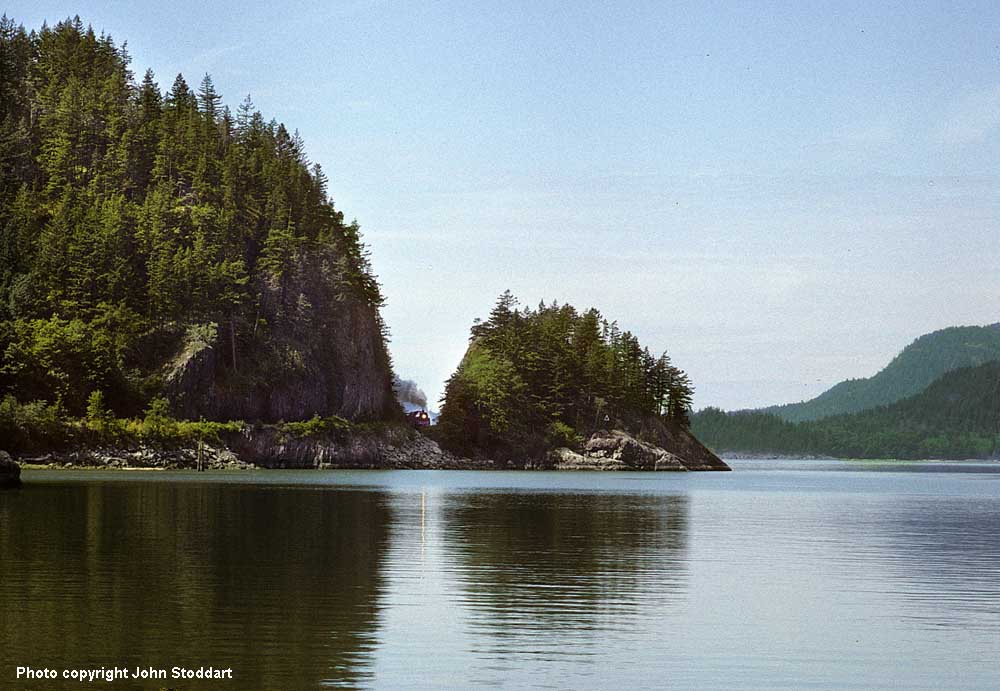
 age evoke fond memories of steam days long since forgotten...if you wish to discuss the contents of this page, John's email address is at the bottom of the page.
age evoke fond memories of steam days long since forgotten...if you wish to discuss the contents of this page, John's email address is at the bottom of the page.Pre-train spotting railway memories are mostly of the branch line to Seacombe, across the Mersey from Liverpool and, with three platforms, as close as the Wirral Railway came to a major terminus. It was the starting point for day trips with mum to places like Caergwrle Castle, about twenty miles away. Fowler 2-6-2 tanks hauled trains of three or four non-corridor coaches, always filthy, always near empty. For young lads, the compartments of these old coaches, inaccessible between stations, were perfect mobile dens. Seats as thickly upholstered as a matron's bosom and luggage racks from which to launch ourselves onto them, raising clouds of sulphurous dust. Windows as opaque as a fish pond were raised and lowered by means of a leather strap like a barber's shop strop. The line closed in 1960 and became an approach to the new Mersey Tunnel.

6922 Burton Hall pulls away from Chester General's Platform 2 with an evening train for Wolverhampton
Trainspotting started in the late 50s when my parents used to take us to the Robin Hood Holiday Camp in Prestatyn, a sort of poor man's Butlins if you can imagine such a thing. Chalets had been shoehorned, army camp style, onto a gravelly strip of land between the North Wales coast road and the main railway line where kids used to congregate to get away from their parents. We watched train after train carrying pasty-faced holidaymakers west and bringing their calamine-coloured, and smothered, counterparts back. Most of the engines were Stanier Black 5s, BR Standard 5s, or 'Crabs'. A very occasional 'namer' was celebrated with cartwheels by those kids who knew how to do them. One particular 'namer' inspired outrageous cartwheeling. Its number began with a 6 instead of 4 and it was called 'Harry Hinchcliffe', perhaps the name of some comedian doing a turn at a camp up the coast, I thought. When I googled him today I come up with a mythical tomb-robber, some link to bestiary and an accordion player. Seems like I wasn't far out.

(Above) 7922 Salford Hall bringing a rather short train past No 6 box into Chester. Behind the engine is the embankment into Northgate Station and, I believe, 6D shed. The building on the extreme left skyline with the imposing spire is that great seat of minimal learning, Victoria Road Primary School, underneath which all GWR and LMR trains bound for North Wales, passed.
Real trainspotting started when we moved to Chester in 1957, 200 yards from Chester General Station. From my bedroom window I looked over empty stock sidings at the western and northern approaches to the station as well as the line into Chester Northgate station on an embankment in the distance. Here was a train spotting cornucopia and no shortage of namers, thanks to the GWR. At school, I put my hand up for Inkwell Monitor after learning that inkwell duty coincided with the passage of the down Irish Mail through sandstone cuttings below the school. While two boys made up the days supply of ink and a third kept guard at the storeroom door, the fourth of the inkwell quartet hung onto life by a hair, extending far out of
 the window to catch the number on the engine passing two hundred feet below. At the first geyser of steam out of the tunnel mouth he yelled and we scrambled for our view of the cutting between his legs. That's how I first met 70045 "Lord Rowallan", a real name this time, not some music hall jester. Actually, as a sort of head scout it turns out, Rowallan was nothing more than a superannuated version of us inkwell monitors, but at least he had the sense to loan his name to an engine.
the window to catch the number on the engine passing two hundred feet below. At the first geyser of steam out of the tunnel mouth he yelled and we scrambled for our view of the cutting between his legs. That's how I first met 70045 "Lord Rowallan", a real name this time, not some music hall jester. Actually, as a sort of head scout it turns out, Rowallan was nothing more than a superannuated version of us inkwell monitors, but at least he had the sense to loan his name to an engine.(Left-Below) Class 40 heading through the sandstone cuttings southwest of Chester General. It is about to pass under Victoria Road School where, in my imagination, latter-day inkwell monitors are doing some clandestine train spotting. Except that inkwells were long gone at the time of this picture, perhaps the school itself too. (Below) 46156 The South Wales Borderer leaving Platform 4 with a train for the North Wales Coast. As an Edge Hill engine in 1959 (although that does not look like an 8A shedplate in this picture) it was a common sight in Chester. The less couth of the train spotting fraternity would have called it a "stink". On the right were the GWR bays, 3, 2, and 1. Stanier Class 4 tank engines would hook onto the back of trains brought in by GWR engines, for the final leg to Birkenhead Woodside. Here, a jinty looks like it is taking stock out of one of the bays to the carriage sidings just off-picture right. The Jubilee class in the background right, is occupying the usual parking place for GWR engines waiting to back onto a train brought into the bays from Woodside. I lived two hundred yards away from the right hand edge of this photo.


6964 Thornbridge Hall bursts from under Hoole Bridge with an afternoon Chester-Shrewsbury train.
So I started to haunt Chester General. Not the station itself, because platform tickets cost a penny and at various times station staff got on their high horses about spotters, persecuting them with a zeal that, at this distance in time, strikes me as worthy of psychiatric analysis. Most spotters congregated either side of Hoole Bridge at the west end of the station where you could see ninety percent of both LMR and GWR action. Ignorance is bliss and I found out, a few years later, that the odd train from Manchester or the other side of the Pennines would sneak into the bays on the east side. Late one summer Saturday afternoon I chanced on 46145 'Duke of Wellington's Regiment, West Riding' sitting in one of those bays at the head of a special from Leeds. A 55A engine, it gave me months of bragging rights over lads clumped at the opposite end of the station looking at 'Misterton Hall' for the umpteenth time.
At first I just marked down numbers and names in a ruled book but soon realized I'd better join Ian Allan's legions and, unable to afford the 'combine', forked out for his LMR and GWR subsets. It was the start of an outpouring of cash into railway books that, for me, still hasn't stopped.Chester was rich in variety of both Midland and Western loco power back then, as I came to understand, underlining numbers in almost every class over the summer months. Plenty of namers too, Halls, Granges, Counties, Castles, Manors from the Western Region, Scots, Pats, Jubs from the LMR, Brits from both sides of the family. I would have, should have, been a happy little lad. But my Ian Allan ABCs unlocked a nasty little secret. In the GWR section there were 30 engines with the names of English Kings that never showed up at Chester General. Likewise two classes from the LMR, 'Coronations' and 'Princesses'. What started as an "Oh, well," gradually became an obsession that took firm root when I found that some of Ian Allan's black and white photos disguised red engines. Red engines. Think of it. Offsetting all this dirty black, dirty green and paint that was totally unidentifiable, there were engines actually painted red. I saw pictures to prove it and the horrible truth dawned on me. I was trainspotting at a second class station. I was being excluded. Today, I could be described as having a syndrome, except they hadn't been invented yet.
 (Right) 9F takes a long mixed goods train around the curve to the northwest of Chester General, the route towards London for all GWR trains and towards North Wales for the LMR. I could see this curve from my bedroom window, sometimes just the tops of engines if sidings inside the curve were full. Many's the time I charged out of my house down to the station to identify an engine whose chimney I had just seen. I had a pair of plastic binoculars, but they gave roughly the same magnification as the naked eye with the addition of diffracted rainbows around the image.
(Right) 9F takes a long mixed goods train around the curve to the northwest of Chester General, the route towards London for all GWR trains and towards North Wales for the LMR. I could see this curve from my bedroom window, sometimes just the tops of engines if sidings inside the curve were full. Many's the time I charged out of my house down to the station to identify an engine whose chimney I had just seen. I had a pair of plastic binoculars, but they gave roughly the same magnification as the naked eye with the addition of diffracted rainbows around the image.Apparently, loading gauge or permanent way restrictions kept Kings out of Chester, something to do with the Dee bridge having already fallen into the river once or Platform 3 having a funny curve on it. A friend and I took a train the short distance to Ruabon to meet an enthusiasts special there, rumoured to be King-hauled as far as that station. It showed up behind a Castle and was changed for something the conoscenti called a 'Dukedog', a quaint thing with outside frames looking like something over which O.S. Nock might get drooly, but doing nothing for me.
If, today, I cannot understand why I didn't travel the 20 miles to Crewe or perhaps double that to Shrewsbury where these forbidden delicacies were available en masse, all that means is I've forgotten how broke I was back then. Anyway, the problem was mostly solved a year or so later when I was grizzling to one of my classmates about Chester's shortcomings as a trainspotting venue and he twigged me to the fact that the 9.05 a.m. to Holyhead, originating in Crewe, had been showing up recently behind a 'Semi'. Although I refused to believe him I had to leave room for doubt. My spotting activities had ebbed over the winter and even at their peak hadn't encompassed 9 a.m. starts. Next Saturday I was down to the station like a jackrabbit, up to the head of platform 4 at one minute before nine where, already cocooned in a cloud of morning steam stood 46220 Coronation. The fact that it was green, not red, was immaterial. Nothing marred that first sighting of 46220 on a monochrome April morning. I had no camera with me, neither did I need one. The picture is etched on my brain.
(Below) Slumming it. 46256 Sir William A. Stanier, FRS, pulls
out of Chester for Crewe with a train of mixed empty stock.

ENGINE SHEDS
When I first started trainspotting Chester had three sheds, 6A, 6E and 6D - the latter being a tiny thing serving Chester's second station, Northgate. 6E was the old GWR shed, right by the station, full of interesting things but very difficult to get into. Both of these sheds closed some time in the late 50s/early 60s. 6A was a way south east of the station between the Crewe and Manchester lines in the middle of a sort of wasteland. A ramshackle affair nondescript even by engine shed standards, it was approached by a dirt path that ran alongside the yard before circling round the back to the official entrance.

(Above-Below) From this picture I'd say it was a good thing the steam engine didn't make it into this century. New-agers allergic to perfume, pollen and life in general would have melted into the cinders, happening on this. Chester's 6A yard, side view, with a Scot and a couple of Black 5s. The Shropshire Union canal was just beyond the shed, and that house on the left housed a lock-keeper. (Below) The path to 6A shed. Most of what was worth seeing was usually out in the yard, often ex-works engines on a quick run-in from Crewe. Ex-works Semis looked odd in the middle of this lot, like go-go dancers in a theatre back alley.


(Above-Below) The late Jim Carter's shot of 46248 City of Leeds on the Crewe line out of Chester. The train is about to pass 6A shed. You can just make out the path to the shed on the embankment, and the gentleman with the bike is probably heading out to work there. (Below) 6201 Princess Elizabeth coming into Chester from Crewe on an 'enthusiasts' special' in the summer of 1993. Believe it or not, behind the first coach is where I stood thirty years earlier to take the shed yard shot above. Chester 6A was just off to the right. It all looks very 'hygienic' now, I suppose, including 6201 which looks more like a Hamilton Ellis painting than a steam engine. But if I had a choice between returning to the '63 or the '93 scene and spending an afternoon there, it's '63 in a heartbeat.


(Above) To bunk 6A, there was no need to consider the official entrance. You simply left the approach path at a point of your choice, walked across the yard, and you were in. To my knowledge there are no official rankings, but it had to be the easiest shed in Britain to bunk. Vaulting ash pits and skipping around moving locomotives at will, I cannot recall ever being asked what I was doing there. 70033, formerly Charles Dickens and a Manchester engine, replenishes at 6A's high-tech coal station.
 I loved shed-'bunking'. It often involved some climbing, a little hide-and-seek, brazenness, the thrill of the chase, all special things for boys who will be boys. The pleasure survived into teenage years. Shed reputations ranged widely. Crewe 5A varied according to the moon, more probably the mood of the foreman. But Crewe South, 5B, was always ridiculously easy. It involved a fair walk from the station but was worthwhile. Engines from everywhere collected there en route to and from Crewe Works. In Scotland, all sheds were easy to 'bunk'. They seemed to exist solely for the pleasure of spotters. At the other end of the scale 34A, Kings Cross, was reputed to be the toughest shed in Britain. There was story circulating that one gritty trainspotter had even donned a railwaymans' overalls to do 34A, and hadn't survived five minutes.
I loved shed-'bunking'. It often involved some climbing, a little hide-and-seek, brazenness, the thrill of the chase, all special things for boys who will be boys. The pleasure survived into teenage years. Shed reputations ranged widely. Crewe 5A varied according to the moon, more probably the mood of the foreman. But Crewe South, 5B, was always ridiculously easy. It involved a fair walk from the station but was worthwhile. Engines from everywhere collected there en route to and from Crewe Works. In Scotland, all sheds were easy to 'bunk'. They seemed to exist solely for the pleasure of spotters. At the other end of the scale 34A, Kings Cross, was reputed to be the toughest shed in Britain. There was story circulating that one gritty trainspotter had even donned a railwaymans' overalls to do 34A, and hadn't survived five minutes.(Left) For me this picture, taken I believe at Polmadie, captures the essence of shed-bunking: the slickness of oil under foot, greasy rails, engines snoozing steam everywhere, latent power, always the chance that something will start moving, silhouetted figures that may or may not be hostile, the hot smells, the dripping of water.
BRITS
In the late 50s and early 60s a Chester trainspotter knew of two kinds of Brits: common as boredom, and as fabled as the phoenix. Into the first category fell ten Manchester-based engines like 70031 Byron and 70043 Lord Kitchener, and the five Holyhead locos that couldn't go anywhere without passing through our station, like 70045 Lord Rowallan and 70048, eventually given the honeyed title 'The Territorial Army 1908-1958'. All the rest were based down in East Anglia, Cardiff, Leeds or Glasgow, homes of rare-to-impossible engines for us. One 66A engine, 70051 Firth of Forth issued from Crewe works late one summer's afternoon in fresh green paint coupled to another Polmadie loco, 46224 Princess Alexander, and named 'Micky' 45154 'Lanarkshire Yeomanry', in similar condition. It was the most heart-stopping combination of steam locomotives I ever saw and threw the spotting fraternity of Crewe station into conniptions. I can just see the staff at Crewe works sending them out, just after 4 in the afternoon when the station went through a drowse, saying, "Watch this, lads!"

(Above-Below) I wish I could be more helpful with this picture but with the special board covering the front number plate, the name gone and the cab number dazzled out, all I know is that it's a 5B engine (there were lots of those after Eastern and Western regions got rid of their Brits). The setting and sun angle are the 'spit' of the top of Chester's engine-turning triangle in the early evening, on the Birkenhead line. But I suspect this is actually in Scotland. (Below) One of the former East Anglia Brits, 70038 Robin Hood, here at Carstairs I believe and carrying a Carlisle Kingmoor shedplate. Believe it or not, the engine is painted green.

 (Left) Over the a period of about 6 summer Saturdays Chester was host to a special from Cardiff often worked right through by one of their 'Brits'. Liz Taylor in decollete would not have caused a greater sensation, sweeping round the curve to the west at 3.30 in the afternoon to the babble of hordes of spotters clustered at that end of the station. Cardiff 'Brits' were invariably cleaner than our usual ones and the rail-less smoke deflectors with their brass step notches lent them an exotic aura. 70025 Western Star taking the Manchester line out of Chester. As one of the former Cardiff Brits, this engine in this location would have caused train spotting palpitations at one time. Presumably, the photo is taken after the mass move of Cardiff's engines onto the LMR. Then Cardiff and Eastern Region got rid of their Brits almost simultaneously, LMR picked them up and suddenly they were everywhere. So we got to cop them. But it was a hollow victory, as if you'd finally got a long-pursued girl to come to the pictures with you, and found she'd been with half the lads in your class.
(Left) Over the a period of about 6 summer Saturdays Chester was host to a special from Cardiff often worked right through by one of their 'Brits'. Liz Taylor in decollete would not have caused a greater sensation, sweeping round the curve to the west at 3.30 in the afternoon to the babble of hordes of spotters clustered at that end of the station. Cardiff 'Brits' were invariably cleaner than our usual ones and the rail-less smoke deflectors with their brass step notches lent them an exotic aura. 70025 Western Star taking the Manchester line out of Chester. As one of the former Cardiff Brits, this engine in this location would have caused train spotting palpitations at one time. Presumably, the photo is taken after the mass move of Cardiff's engines onto the LMR. Then Cardiff and Eastern Region got rid of their Brits almost simultaneously, LMR picked them up and suddenly they were everywhere. So we got to cop them. But it was a hollow victory, as if you'd finally got a long-pursued girl to come to the pictures with you, and found she'd been with half the lads in your class.LAST TRAIN TO...
Towards the mid-60s, with steam disappearing fast, 'enthusiasts' specials' proliferated. At first they were beyond my means but viewing them lineside or from platforms was free, and if the straying of engines far beyond their home territory tempered their scarcity value, it was a thrill and novelty to see them. West Country pacifics at Crewe, A4s at Chester, 'Flying Scotsman' everywhere, all this helped deaden the sting of steam's disappearance.
Then I started work down in Birmingham and could afford to board as well as look at them. Their relationship to plain-jane, anonymous railway travel was about that of TV's survivor-style shows to reality. I bought tickets in response to railway magazines ads placed by organizations with names like 'Stanier Black 5 With Skefko Bearings, Caprotti Valve Gear and 3500 Gallon Tender Preservation Society'. I jumped at the chance to say, 'Farewell to the Gurbling-Under-Burdock branch line' even though I had look at a map to find out where Gurbling-Under-Burdock was. I was a puppet dancing to that medley of collection-mania and nostalgia that is at the core of a spotter's psyche.

(Above) 60024 Kingfisher at Newcastle with an A4 Preservation Society Special from Doncaster, 1965 or 66. I am one of two trillion photographers taking this very same picture.
So I travelled the length and breadth of the country, finding myself looking for the first and last time at stations and engines I'd never seen before and haven't since. On board these last-chance cavalcades rows of drab-looking men in raincoats sat facing eachother in silence, like government clerks on the 5p.m. back to Hemel Hempstead or fans bound for a National Dominoes Tournament, perhaps first line supervisors en route to a Shoelace Manufacturer's Convention. At designated photo stops they morphed into kindergarten lunatics, jostling each other along and off platforms to take identical pictures of the same locomotive. At that age I had neither the confidence nor the gift of self-analysis to realize and accept that these events weren't my cup of tea. My love for railways wasn't as simple as I had thought. It wasn't a love of steam, or trains, or railway practice. It was love of a particular time and place, its ambience and relationship to a point in my life. It was like the view from a train window: there for a while, now behind, now gone and never to be recaptured exactly as it was. I realized it was time to close the book and consign the best bits to memory.

(Above-Below) Not 'enthusiasts specials' but their close cousin. Derby Works Open Day in the early 60s, engines like tailors' dummies, crowds of people. I now find these pictures as interesting for the people as the locomotives. The kid in front of D57 is wearing typical spotter garb of that era, complete with combine stuffed into his back pocket. All that's missing is the duffle bag.

At age 18 I left school and went to work in Birmingham. These were the last years of steam in Britain and my contact with my old passion was limited to one final, sad trip to Scotland, watching some heavy goods workings around Wednesbury when I took the train there for evening school on Thursday evenings, and participation in a few 'last chance' specials. A 'Farwell to the Former Great Western Railway Line Birmingham-Chester' railtour on March 5 1967, gave me the opportunity to take one last look at something that had been a major part of my life and I was able to hang around Tysley watching 'Clun Castle' being steamed up for various events. At the time of writing this I'm still looking for my photos from those years.
Happily I was too preoccupied with other things to let the decline of steam eat at me; like, how to get out of Birmingham and the numbingly boring job I was doing. Nevertheless, I had to witness this heartbreaking moment below...in befittingly funereal weather, 46235 City of Birmingham, withdrawn from service November of 1964, is laid to rest in a museum in its namesake city.

WORKING THE REFRESHMENT TROLLEYS AT CHESTER GENERAL
In the early 60s I got a summer job in the refreshment services at Chester General. Over my working life it was the first of two opportunities I had to combine a hobby with the mundane process of earning a living, and this time it turned out spectacularly well. Sometimes I had to work in the buffet itself but most of the time I was one of four lads selling off refreshment trolleys on the platforms. I could pause here for five minutes of music-hall jokes about B.R. sandwiches, but in all honesty they were the nearest anything on my trolley came to edibility. Made every morning from quality ham and fresh bread with real butter, what they lacked in imagination they made up for in wholesomeness. Which is more than can be said for the sweets, chocolate and Gala Fruit Pies that made up the balance of my cargo. Plus a gasometer-sized container of tea. As you would expect, this was only drinkable for the first hour after brewing, after which I was hopefully ready for a refill. Otherwise I prayed the train I was serving would be whistled out promptly. Some people on holiday extras pulling into platforms 8 or 10, perhaps old customers of mine, figured the product available at the buffet adjacent to those platforms would be a better bet. I suppose I should have warned them of the risk but I doubt they would have listened and besides, why spoil a good show? The sight of shirtsleeved, teacup-loaded men issuing from the buffet in time to witness the tail-lights of their train disappearing towards Llandudno, lightened the dullest day.
We were booked to work from about 8.30 to 4.30 or 5, but so much did I enjoy the work that I would often stay to eight in the evening, crossing from one side of the station to the other to meet trains headed up towards Holyhead or back to London, Manchester, Birmingham, you name it. On a summer Saturday the procession was endless, and endlessly varied.

(Above-Below) One of the star turns at Chester was the late afternoon express that left Bangor for London at 12.30. It was usually worked from Chester onwards by a Pacific that had come down from Crewe earlier in the day. For me this picture epitomizes those late summer afternoons when I used to work the refreshment trolleys on the station. 46229 Duchess of Hamilton awaits the right away. (Below) Trainspotters congregated at the west end of Chester General. There you could catch most of the worthwhile GWR and LMR traffic. But photographic opportunities were better at the east end. From its number, the date of this photo (summer of '62 I think) and the condition of the loco, this EE Type 4 might have been not long out of the box. Starting south, or east if you will, from Chester with a London train.

It was here that I met Chris, my partner on that first Scotland trip in 1964 (see previous page). He was designated to travel the trains with his trolley, a kind of Lone Ranger to us small-town sheriffs. There were rules. He was to stay clear of trains manned by the Manchester refreshment men, and those with restaurant cars. Rules, to Chris, carried less force than mild suggestions or hints. He was the buccaneer of railway refreshments. If he wanted to work a train already boarded by a Manchester man, he would do a quick calculation of the travel time to the next stop, identify his competitor's location, and board the train far enough away to give him a decent haul of customers without being discovered before jettisoning. That was the theory anyway. More than once the tortured sound of trolley wheels well over their speed limit preceded the bulldozing of the buffet's double doors that announced Chris's flight for asylum, pursued by an irate Manchester refreshment vendor. Letters and phone calls of complaint to Mrs. Edwards, the refreshment services manageress, were legion.

(Above) Black 5 44661 helps an unidentified EE Type 4 take a train from the North Wales Coast out of Chester to Crewe. I had always thought railway workings were highly structured, everything preordained. But, especially on summer weekends, this turned out not to be so. With all kinds of equipment pressed into service, specials arriving from every direction, anything could happen. I recall a station inspector just about filling his pants one damp Saturday afternoon when a Jub and Mickey showed up double-heading a coast-bound train into platform 10. "What the ***!!!!," he yelled, then to the driver of the pilot, "You! Get off to the shed!" Obviously something or other was not according to Hoyle.
As I found out later in Scotland, nothing pleased Chris more than making tight connections, impossible ones even better. Piloting his trolley through a train like a Roman Charioteer, he was able to clean out a ten-coach rake inside one or two stops. Photographic retention of the timetable had already laid out for him the departure times of all trains headed in the opposite direction, and Chris had targeted his next payload. That would often mean a frantic switching of platforms, trolley and all, at stations with neither lift nor track-level crossing. Spittle and hair flying, he would burst from his inbound train yelling to railway staff to hold the one outbound at the platform across the tracks while he manhandled his refreshments over a footbridge. One he dropped the whole lot on the ballast. Like most self-obsessed and driven people, he was oblivious to the wake he left behind him, and flabbergasted when it occasioned a strong reaction. "Flewitt threatened to hit me!" he complained to me once, eyes wide with disbelief and injury. Flewitt was
 Mrs. Edwards' assistant, a tall, grim ogre of a man, who shared none of her half-concealed admiration for 'The Big Noise from Bebbington' and amused tolerance for his escapades. I often wonder what became of him. Chris, if you ever read this, please don't tell me you became a civil servant, married and had 2.3 kids. I couldn't stand it.
Mrs. Edwards' assistant, a tall, grim ogre of a man, who shared none of her half-concealed admiration for 'The Big Noise from Bebbington' and amused tolerance for his escapades. I often wonder what became of him. Chris, if you ever read this, please don't tell me you became a civil servant, married and had 2.3 kids. I couldn't stand it.(Left) Black 5 and Brush Type 4 pass Chester's Roodee racecourse and cross the Dee bridge. This is the second bridge, the first having collapsed back in 1847 - one of Robert Stephenson's less celebrated engineering feats. It was rumoured that restrictions on this bridge kept GWR Kings out of Chester.
(Below) A common scene but a not-so-common engine. This is one of my very few pictures taken at the west end of Chester General, the normal spotting end. Those who didn't want-couldn't afford a platform ticket would spot from the goods road behind the coal wagon in the background, or from Hoole Bridge steps directly behind the photographer. The engine is 5002 Ludlow Castle, a Swindon locomotive and a rare visitor to our part of the world. Our usual 'Castles' were Wolverhampton or Shrewsbury based, like 5070 Sir Daniel Gooch and 5097 Sarum Castle. I always thought the Castles were amongst the most handsome steam engines and, alongside the toy-like Manors, my favourite GWR class - even in a filthy condition.


(Above) 46245 City of London, unmistakably red, appears to be passing non-stop through Chester General here, possibly with up empty stock since I can recall very few passenger trains, apart from holiday camp specials for the coast, working non-stop through the station.
Perhaps the highlight of my part-time career at Chester refreshments came later, in my last year at school, when I was called in to work an off-season special to Stratford on Avon. With Flewitt, I was to man a mini buffet in a twelve-coach train full of fifth form schoolgirls off to see a performance of King Lear. Aside from the guard, driver, fireman and Flewitt, who looked like an oversized Ben Kingsley after a bad night on the bottle, I was the only male. Never have I been the target of so attention and flirtation, even in later years when I worked summers as a lifeguard at a local pool. We were hauled there and back by a Brit, but I can't remember which one. I was too busy posing and posturing.
Many years later, during a rare visit to Chester, I sat on a bench alongside platform 8 at Chester General, the station now a ghost of its former self. There seemed to be no connection to my summer workplace of the early to mid-60s. Hardly anything moved. The few trains that slid in were stunted, headless versions of those I had known way back. Could this four-coach runabout actually be a Manchester-Llandudno affair? Then there was the sudden metallic slide and crash of lift doors, the lift I used a thousand times to cross the tracks with my trolley, and I was instantly back in 1964. A young girl stepped away from the phone kiosk the other end of my bench, and timidly asked if I had a pen she could borrow for a minute to take down some message, perhaps a phone number she had just been given. Here, have the pen I said - at work, I had drawers-full of them, promo gifts from clients and suppliers. She looked at me strange, stuttered no thanks, and gave it back to me. It was not 1964. I was just an old man, frightening a young lady by offering her a gift.
(Below) D222 parked under the old Hoole Street entrance. Probably taken in the late 60s or early 70s not long before I left the UK. The footbridge has long gone, as has almost everything in this photo except the rain.

LNER PACIFICS
By the early 60s we could see every class of LMR and WR engine in Chester except 'Kings'. No Southern Region engines of any description, but that didn't bother me. Southern Region was tinny engines going piddly distances to my way of thinking. The old LNER was a whole different story. Aside from the occasional B1 - surely one of the ugliest engines ever to turn a wheel on British railways - and something equally nondescript drifting into Chester Northgate (over which the LNER had traditional running rights), few North Eastern Region locos showed up in our area. To a growing trainspotter, this was unacceptable. NER had some of the most famous, best-looking, most exotic locomotives in the world. I had to go see some.

(Above-Below) This picture mystifies me. As far as I can recall, I only saw 60001 Sir Ronald Matthews once, at Doncaster Plant. The building behind looks right. Yet I'm positive I didn't have a camera at that time. So this is probably at Edinburgh, St. Margarets or Haymarket. (Below) 60052 Prince Palatine at Aberdeen. Sadly, one of my very few photographs of my favourite class of locomotive and looking a little worse-for-wear.

In particular, I had to see those amazing A4s and, my all-time favourite engine, the A3 with - wait for it - 'jerry blinkers'. I just could not agree, still can't, with those who said 'jerry blinkers' ruined the look of the A3. For me, they transformed a slightly old-fashioned looking lady into something rather racy, one of those older women who render a teenage boy dry-mouthed and sweaty-palmed. A3s had it all; a history of impressive performance, great looks, and the best names. Those names, 'Blink Bonny', 'Tagalie', 'Shotover', 'Galtee More', told you LNER men could see into the soul of a steam engine. To see any North Eastern Pacifics I would have to travel further than I had ever gone in my train spotting life. Short of cash, Leeds was the cheapest day-return likely to produce the goods and on a busy day during which I 'bunked' both Holbeck and Neville Hill, I did see my first NER pacifics. But they were A1s, much better than nothing but still leaving me feeling a bit short-changed.

(Above-Below) The A1s were my least-favourite LNER pacifics, A2s a cut above. I particularly liked A2 names, illustrious ones like 'Cock o' the North' and a good mix of famous race horses. 60528 Owen Tudor heads south out of Stirling with an evening train for Glasgow. (Below) 60532 Blue Peter poses here at Perth shed.

One leg further than Leeds, but still reachable on a reasonable day-return ticket, was York. It was there, at 50A, I saw my first A3s, 'Spearmint', 'Ladas' and 'Minoru'. Beautifully turned-out, wearing their lined green and black like royalty, brass names glittering, they fulfilled all expectations. But I returned to the station A4-less and an hour away from having to catch my train home. It was while I was crossing one of the station footbridges that I heard an odd sound, the kind of half-cheering/half screaming noise over-excited schoolboys make, against the most peculiar background, a kind of hollow hushing. I turned and started to run towards the din just as the unmistakable coxcomb of an A4 chimney glided past the footbridge deck. 60013 'Dominion of New Zealand' on a down train. It is one of a dozen or so indelible train spotting memories, my first A4. Over the next couple of years I was to cop the whole class, 16 of them one unforgettable summer Saturday in Doncaster at the station, shed and Plant. I was to ride behind them many times on the Glasgow-Aberdeen three hour expresses and special trains. From any angle, they were fascinating engines and the thrill of seeing one never lessened.

(Above-Below) Catching the eye from any angle. 60009 Union of
South Africa at Perth, 60031 Golden Plover heading south from Perth.

MOUNTAINS AND HUDSON
Steam in Canada.
I escaped from Birmingham and the desiccating effects of office work by going to Liverpool University for 5 years to take a BA and MBA consecutively. Happy years, particularly the first three. But by the spring of 1972, pending decisions, until now vibrations on a rail, took on the clamour of an onrushing express. In a few months I would have to leave school and earn a living.
Return to Birmingham was out of the question. However, most of the jobs I wanted were based either there or in London. Early in the summer of 1972 I visited a friend who had graduated the year before, married and found work in London. He lived near Upminster, in a suburb that was the prototype for the opening scenes of Fall and Rise of Reginald Perrin. Every seven minutes electric trains rattled like computer printout past the bottom of his garden. He took one of them at 7.30, five days a week, into London and another one back at 5.30. Living there for the last nine months, he had yet to exchange words with either neighbour. Walking past nearby houses, the only indication that any were inhabited was the occasional sign in a garden advertising "Second Prize, Hybrid Tea, East Dunwoody Rose Society". It was a freezing summer, the second in succession. On no day, in the northwest at any rate, could you chance going out without a jacket. I decided to emigrate.
 Early one midsummer Sunday morning in 1975 I was out with my new girlfriend driving through a deserted downtown Toronto going nowhere in particular, as people worldwide do on Sundays. It was one of those opaque, southern Ontario summer days. Air, land and water had the same colour and consistency, overused dishwater not quite gone cold.
Early one midsummer Sunday morning in 1975 I was out with my new girlfriend driving through a deserted downtown Toronto going nowhere in particular, as people worldwide do on Sundays. It was one of those opaque, southern Ontario summer days. Air, land and water had the same colour and consistency, overused dishwater not quite gone cold.Driving down Spadina Avenue across the tracks at the west end of Union Station, my heart jack-knifed. Leeching into the Lakeshore mists, a column of steam mounted and moved towards us like a prairie twister. I threw the car into a U turn across six, fortunately empty, lanes and mounted the sidewalk with my four-way flashers going, feeling behind me with my free hand for my camera.
Across the railyard CN 6060 was marshalling cars for a special train bound, we subsequently found out, for Orillia, 70 miles north . There was an immediate choice to be made: do I tell this girl, who up until now probably thought I was normal, that I was, or am, potty about steam locomotives? Like former wives and girl friends, it seemed to be one of those subjects you just don't discuss with a woman until the relationship is on an unshakeable footing. In all honesty I can't recall how I phrased the confession, but these pictures prove we spent the rest of the day chasing around southwest Ontario. It didn't jeopardize the relationship. Maybe it even helped, spiced up an otherwise-bland character. Because the girl became, and still is 34 years later, my wife (Above) 6060 marshals its train in Toronto's Union Station yards.

(Above-Below) 'Bullet-nose Betty' 6060 preparing to return to Toronto from Orillia, summer 1975. Train spotters, or whatever fancy name you want to give them, have much in common the world over. There is nothing quite like getting up close and personal with a steam engine, to get your heart thumping. For the technically-inclined, a few notes about 6060: Built at Montreal Locomotive Works in 1944. Length is 93 feet, height 15 feet 1 ½ inches. Operating weight 637,540 lbs., tractive effort 52,500 lbs. (no booster). Driving wheel diameter 73 inches. Operating pressure 260 psi. Fuel is light crude oil, converted from coal. Tender capacity is 5,000 imperial gallons oil and 11,000 imperial gallons water. One engine of this class ran 18,353 miles in one month. (Below) Terence Cuneo meets Norman Rockwell. 6060 disturbs Orillia's Sunday snooze and gives local fishermen something to shout about.

Sheer coincidence found me a home for the past 30 years overlooking what used to be the British Columbia Railway main line from Vancouver to Prince George, 470 rail miles north. From about May to September, right up to the late 1990s BCR ran a regular steam excursion from North Vancouver to Squamish, a distance of about 40 miles through spectacular scenery. Most of the time Royal Hudson 4-6-4 2860 provided the motive power. Not the most beautiful steam engine I have ever seen, 2860 was still handsome enough to rubbish the preconception I had, coming from the UK, that all North American engines were utilitarian-ugly.

(Above) 2860 was built at Montreal Locomotive works in June 1940. It weighs 648,500 lbs., steam pressure is 275psi, driving wheels 75 inches, tractive effort 42,250 lbs. Length 90ft 10 inches, height 15 feet 10 inches.
 There are two cylinders, 22" diameter, 30" stroke. Here, 2860 bursts out of the tunnel at Tunnel Point. One of the disadvantages newer countries face is that everything has to be named in a hurry, and imagination is in short supply. It's either native Indian or stunningly obvious for placenames along the line. After this the train will pass Windy Point whose main feature is …
There are two cylinders, 22" diameter, 30" stroke. Here, 2860 bursts out of the tunnel at Tunnel Point. One of the disadvantages newer countries face is that everything has to be named in a hurry, and imagination is in short supply. It's either native Indian or stunningly obvious for placenames along the line. After this the train will pass Windy Point whose main feature is …(Right) A murky west coast morning. Nearing its 8 o' clock departure time from North Vancouver station, 2860 eyes up a younger product of Montreal Locomotive Works, 3000hp M630 No 721…and then 2860
 decides to speak, opens its cylinder cocks (left) and gets under way for Squamish...
decides to speak, opens its cylinder cocks (left) and gets under way for Squamish...(Below-Right) Crossing the Capilano River at the western boundary of North Vancouver. From here to Squamish it's mostly single track with plenty of unmanned crossings. Over a very sinuous route, speed will seldom get much above 40 mph, yet level crossing collisions are not uncommon. The average person's grasp of the laws of physics and their application to hundreds of tons of locomotive hauling thousands of tons of train, is poor. The only time I heard of a near-equal outcome was in the Fort Nelson division of BCR in the late 90s, when a fully-loaded logging truck tried to beat a double-headed logging train to a crossing. It was a tie. Both locomotives were knocked off the rails, the truck was totalled, there
 were logs everywhere.
were logs everywhere. Later in my career I took a job with the British Columbia Railway. What started as a rewarding experience in every sense gradually turned into one of disillusionment. This is not the place to go into details. I'll just say that I found a workforce, both union and management, in which some people literally worked themselves to death while others got through the day with a minimum of effort and the sole goal of getting home to watch TV, generated a poisonous and dispiriting atmosphere. One union official boasted he would shut down the railway before he was done. As I write this, his target has been all but realized. Whole divisions were closed before the company was sold to CN, whose probable main aim was to take a competitor out of the market. Where, 10 years ago, kilometre-long trains rumbled by my house through the day and night and the line boasted a passenger train regularly appearing in worldwide "Top 10 Railway Journeys" lists, today the odd 20-30 car train puts in an infrequent appearance. All indications are that CN will close most or all of the line as soon as it legally can, and those employees dying to get home to the TV can watch it full-time. Their kids will have missed the opportunity to play their part in a potentially vibrant and productive organization. They may find world-enriching employment in pursuits with titles like "Personal Wellbeing Consultant", "Lifestyle Counsellor", "Young Canine Obedience Coach" and "Assistant Government Supervisory Administrator". As meaningful jobs evaporate, those whose purported functions take longer to describe than execute, multiply.

(Above) For years the daily Bud Car from North Vancouver to Prince George figured in most top ten lists of Great Railway Journeys. It was dirt cheap, generally empty, and lived up to its reputation. People now spend quadruple its fare to travel one tenth of its journey along the first 40 miles of the same route. I took it once, experiencing the heady thrill of being able to walk down the hill 200 metres from my house with a light bag over my shoulder, stick out my hand at the crossing to flag it down, and spend that night in a hotel 470 miles north of here. All told, it is the most spectacular railway journey I have ever taken.
The south end of the ex-BCR main line is at roughly the same latitude as Paris, the northern limit at about Stockholm's latitude except you're hundreds of kilometres inland so there is no sea influence. Just south of the Yukon border, it is rough country with long and very cold winters. There are more bears than people. Like people, animals love the path of least resistance and in winter, that's the railway line. No moose in his or her right mind is going to struggle through snowdrifts all day when there's a nice, level ploughed route available. Unfortunately, like their two-legged cousins few of them appreciate the laws of physics and through the winter, many moose are hit. However, if you live up there, chances are you're a hunter, the old-fashioned kind who butchers and eats what he kills. It was not unknown, though officially frowned upon, for the Fort Nelson freight to arrive in the yard with a dead moose tied across the front of the locomotive.

(Above) Few of them would admit it, but disasters are to a railwaymen what adultery is to a gossip columnist. I have witnessed men who would rather chew broken glass than apply an ounce of enthusiasm to their day job, gleefully rise unsteadily from a table full of beer in response to an emergency call to spend 72 hours with little or no sleep, performing the labours of Hercules to re-open a line. There were many derailments when I worked at BCR, a good portion of them in the 60 mile section between Squamish and Pemberton where the terrain is especially difficult. The line follows the Cheakamus River for much of that section and unfortunately that's where the derailed cars usually end up. As here, where two cars of pulp are nose-down in the Cheakamus north of Whistler. Since the line has been cleared, they'll probably be there a while. The rather over-dressed lady wringing her hands over them is my wife, who probably wasn't told we would be spending part of the day scrambling around derailed railcars. I would not be surprised if 'environmental sensitivity' is cited by CN as a reason for eventually closing this section. They have had a couple of very costly derailments here since taking over the line, and have been fined heavily for polluting the river. The most inept accountant would have no trouble demonstrating lack of economic viability for this section of the line.
Sadly I didn't realize it at the time, but the late-80s were something of a swansong for steam on Canada's west coast. Dovetailing with Expo 86 in Vancouver, there was a Steam Expo tagged as 'the largest gathering of steam locomotives since the 1948 Chicago Rail Fair.' Amongst other things it featured my old friend from Toronto, CN 6060, which hung around the area, on and off until the late summer of 1988 when it double-headed our daily North Vancouver-Squamish tourist train with local star, CP 2860.
Tootling along a snaking, water-level 60-or-so kilometers of line at 40 to 70 kph, these engines couldn't begin to demonstrate their capabilities. Regardless there's something soul-stirring about 574 tons of steam power, 184 feet from the front buffer of the pilot to the rear of the train-engine tender, in motion. With a
 crystal ball handy I would have stirred myself to spend every daylight hour of the week these engines operated, watching them in action. But at the time it seemed these heady days would go on forever. If only I'd known. 6060 is now largely confined to a short stretch of line in Stettler, Alberta. In the spring of 1999 a pre-season inspection of 2860 revealed serious leaks in the superheater elements and the need for major boiler work. She was taken out of service and parked in Squamish. Years of hard work by volunteers resulted in a last gasp on December 9th, 2010 when I was startled out of my wits by a call from my subconscious, the sound of 2860's whistle coming out of the December rainmist on the line below my house. She ran light engine to North Vancouver, returning with a special that evening. And that was it. At an estimated $1 million to get her back into full, certified, working shape we're not likely to see her again on special duty for the foreseeable future.
crystal ball handy I would have stirred myself to spend every daylight hour of the week these engines operated, watching them in action. But at the time it seemed these heady days would go on forever. If only I'd known. 6060 is now largely confined to a short stretch of line in Stettler, Alberta. In the spring of 1999 a pre-season inspection of 2860 revealed serious leaks in the superheater elements and the need for major boiler work. She was taken out of service and parked in Squamish. Years of hard work by volunteers resulted in a last gasp on December 9th, 2010 when I was startled out of my wits by a call from my subconscious, the sound of 2860's whistle coming out of the December rainmist on the line below my house. She ran light engine to North Vancouver, returning with a special that evening. And that was it. At an estimated $1 million to get her back into full, certified, working shape we're not likely to see her again on special duty for the foreseeable future.These pictures hopefully capture something of those fading late summer days in 1988. The double-header is shown in Squamish poised for the southbound return; leaving for North Vancouver; and I have others passing Porteau Cove where road and rail-line elbow each other for space between cliffs and sea. Composition of the admiring group (below) around the engines in Squamish is internationally recognizable: a single poor lady amongst a gaggle of middle-aged men, one of whom is desperately pleading to 'cab' 2860.

Anybody reading this article will have gathered I'm not a huge fan of the railway special and preserved line experience. It's far better than nothing but can hardly hope to replicate the complete ambience of steam-powered railways in their zenith. Nevertheless I did enjoy a day on the Langollen Railway during a trip to the UK in the late 90s, walking on cinders between sleeping engines (yes, I bunked the shed), the smell of hot oil and coal, hearing again the slam of carriage doors before train departure. This picture at Langollen station isn't your standard three-quarter shot but for me it reawakens something of the feel of a working railway, the relationship between man and machine.

(Below) Let's close on a dreamier note. This photo gives some idea of the scale and difficulty of the BCR Vancouver-Whistler section. Royal Hudson 2860 weaves its way along Howe Sound just south of Porteau. Click on photo to enlarge even more...

Polite notice: All text and photographs are protected by copyright and reproduction is prohibited without the prior consent of the © owners. If you wish to discuss using the contents of this page directly with John his email address is below. Please note - this is not a 'clickable' mail-to link via Outlook Express. You will have to email manually.
jpstod@telus.net




